3 Volumes
Tourist Trips: Philadelphia and the Quaker Colonies
The states of Pennsylvania, Delaware, and New Jersey all belonged to William Penn the Quaker in one way or another. New Jersey was first, Delaware the last. Penn was the largest private landholder in American history.
Regional Overview: The Sights of the City, Loosely Defined
Philadelphia,defined here as the Quaker region of three formerly Quaker states, contains an astonishing number of interesting places to visit. Three centuries of history leave their marks everywhere. Begin by understanding that William Penn was the largest private landholder in history, and he owned all of it.
Nineteenth Century Philadelphia 1801-1928 (III)
At the beginning of our country Philadelphia was the central city in America.
The Main Line
Like all cities, Philadelphia is filling in and choking up with subdivisions and development, in all directions from the center. The last place to fill up is the Welsh Barony, a tip of which can be said to extend all the way in town to the Art Museum.
Albert C. Barnes, M.D.
A private investor has the general goal of accumulating enough wealth so, come what may, there will be a little left when he dies. If he has dependents or heirs, he needs somewhat more. Either way, he is not planning for perpetuity or thinking in astronomical time periods. Albert C. Barnes (1872-1951) had to switch his investment goals, in the 1920s, from investing for a comfortable retirement to investing for a perpetual art foundation. Perpetual.
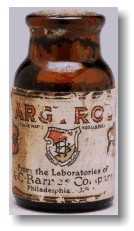
|
| A bottle of Argyrol |
Having graduated from medical school (University of Pennsylvania) in 1902, and then writing a doctoral thesis in chemistry and pharmacology at the Universities of Berlin and Heidelberg, Barnes invented a patent medicine that quickly made him rich. Argyrol was a mildly effective silver-containing antiseptic with the unfortunate tendency to turn its users permanently slate-gray. The advent of antibiotics has since made Argyrol almost sound like quackery, but it was effective enough at the time to require factories in America, Europe, and Australia, and Barnes became immensely rich with it. The American Medical Association strongly disapproves of physicians who patent remedies, so Barnes was never held in high regard by his colleagues; but it could well be argued that he had as much training as a chemist as a physician, and spent his entire professional life as a chemist, manufacturer, and investor.
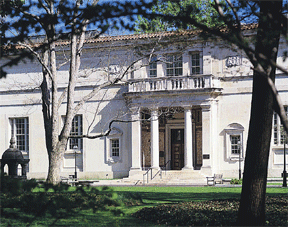
|
| The Barnes Gallery |
Barnes was eccentric, all right, but on Wall Street, the saying goes, "What everyone knows, isn't worth knowing." Guided by that principle, in 1929 he sold his company at the very peak of market euphoria, getting out of common stocks at the top of the market. It is small wonder that he soon instructed his Foundation to invest its endowment entirely in bonds. During the 1930s, commodities were extremely cheap because no one had any money. Barnes, of course, had a potful of money and bought hundreds, even thousands, of artworks very cheaply. He also bought 137 acres of Chester County, PA, real estate, and a 12-acre arboretum in Merion Township on the Main Line. Although he is famous for acquiring hundreds of French Impressionist paintings with the advice of Gertrude Stein and her brother Leo, he also bought great quantities of Greek and Roman classical art, African art, and the art of the Pennsylvania German community. He picked up a notable collection of metallic art objects. Most of these "losers" are down in the basement because he had so many Renoirs, Matisse, and Picasso (some of them may be worth $200 million apiece) that the upstairs galleries were pretty well stuffed with them. Viewed from the perspective of an investor with a goal of perpetuity, of course, the things in the basement just happen to be temporarily out of fashion, just like those bonds in the portfolio.
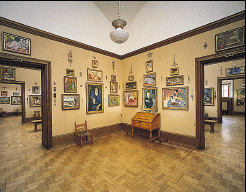
|
| A view inside the Barnes gallery |
Since the Foundation is currently strapped for ready cash, Judge Stanley Ott of the Montgomery County Orphans Court is now being urged to allow the Foundation to break Barnes' will in some way or other. Move the museum to downtown Philadelphia where it can attract more paying visitors. Sell some of that land. Sell some of those paintings in the cellar. Fire some of those employees. But all of these suggestions are short-term solutions, which may injure the long term. Everybody has an idea of what Barnes the rich eccentric would have done if he were alive to do it, but I suspect he would have rejected the whole lot. Barnes the shrewd investor would have taken the most expensive painting off the wall, and sold it to the highest bidder. Buy low, sell high, and the niceties of non-profit professionals are damned. Barnes wasn't in love with one single painting, or one particular school of painterly interpretation, he was in love with Art.
Investment theory has improved in the past fifty years; there have even been some Nobel prizes awarded for new insights. But it still isn't possible to put an investment portfolio on autopilot for perpetuity. Every museum, university, and the foundation has the same problem, with the result that the landscape is littered with the bones of perpetual organizations destroyed by following a fixed formula. With the singular success that Barnes displayed, it isn't surprising that he went a little too far with instructing his successor trustees in what to invest in. Never sell the paintings or the real estate, avoid the common stock, were ideas that worked brilliantly, and may even work most of the time. But sooner or later, the institution will be endangered by following them too literally. Somebody has to have some flexibility. But there is something else that is inevitable, too. Sooner or later, whether it takes fifty years or five hundred years, sooner or later someone will be given the responsibility and the necessary flexibility -- but will try to run off with the boodle, for himself. The balance between necessary prudence and necessary flexibility is impossible to maintain forever, and the Judge will surely have a hard time deciding what Barnes would have decided.
Bertrand Russell Disturbs the Barnes Foundation Neighbors
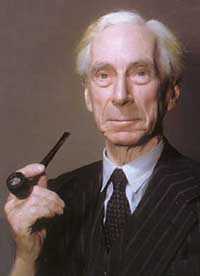
|
| Russell |
In 1940, the Barnes Foundation disturbed its Philadelphia's Main Line neighborhood in a way that had nothing to do with art. Dr. Barnes was still alive and running the place at that time so there can be no question about the testamentary intentions of the donor. He hired Bertrand Russell for a five-year contract to teach philosophy at the Foundation, under highly lurid circumstances. By doing so, he put his thumb in the eye of religions generally but especially the Roman Catholic Church, into the eye of the Main Line neighborhood that prized its privacy, and into the eye of the judiciary, although the judiciary found a way to get back at him.
 Do not fear to be eccentric in opinion, for every opinion now accepted was once eccentric. 
|
| Bertrand Russell |
Under the circumstances, hiring anyone at all would have been socially defiant, but Barnes went out of his way to offer a position to a man who was already internationally famous for sticking his own thumb in everybody's eye.
Lord Bertrand Russell was the third Earl, the son of a Viscount and the grandson of a British prime minister. He had such a brilliant mathematical mind that no less an observer than Alfred North Whitehead regarded him as the smartest man he ever met. He burned up the academic track at Trinity College, Cambridge, and was made a Fellow of the Royal Society at an early age. There was absolutely no one in the academic world who could look down on him, particularly no one in any American community college. His association with Haverford Quakers was established by marrying Alys Pearsall Smith, a rich thee-and-thou Quakeress then living in England, whose brother was the famous author Logan Pearsall Smith. Many early letters of Bertrand Russell contain instances of what the Quakers call "plain" speech.
 If a man is offered a fact which goes against his instincts, he will scrutinize it closely, and unless the evidence is overwhelming, he will refuse to believe it. If, on the other hand, he is offered something which affords a reason for acting in accordance to his instincts, he will accept it even on the slightest evidence. 
|
| Bertrand Russell |
By the time of World War I, this odd mixture of Quaker pacifism and English aristocratic arrogance seems to have unhinged Russell from social moorings, and he began a lifelong career of defiance mixed with a rapier wit that made just about everybody his enemy. He went to jail for pacifism, got divorced three or four times, openly slept with the wives of famous people like T.S. Eliot, and proclaimed that monogamy was not a natural state for anybody. He wrote ninety books, and his denunciation of religion was sweeping. All religious ideas were, in his view, not only false but harmful. Accordingly, everybody in polite society kicked him out, and although he was entitled to a seat in the House of Lords, by 1939 he was nearly impoverished. In desperation, he went to (ugh) America to seek his fortune. He didn't last at the University of Chicago, and even California eased him out. Finally, he was reduced, if you can imagine, to accepting an offer to teach Philosophy at the City College of New York. That proved to be totally unacceptable to Bishop Manning, who led a public outcry against using public funds to support such a radical, known to have held long conversations with Lenin. When a CCNY student was induced to file suit along those lines, an especially hard-nosed judge overturned the College appointment, with the rather gratuitous declaration that Russell's appointment would establish a Chair of Indecency. At that point, Albert Barnes stepped in and offered Russell a five-year contract to teach philosophy at the Barnes Foundation on Philadelphia's main line.
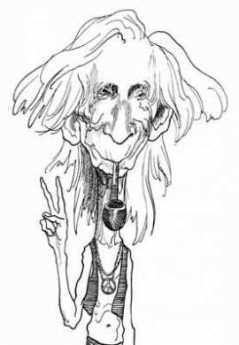
|
| Bertrand Russell in 1960s regalia. |
Bertrand Russell the bomb-thrower accepted the offer and came down to that quiet little lane where the neighbors object to the traffic coming to look at pictures. The five-year contract only lasted three years, when even Barnes got fed up, and summarily dismissed him. The circumstances have not been extensively documented, but they were sufficient to enable Russell to win a lawsuit for a redress of grievances. During that three year period on the Main Line, he had produced a book called History of Western Philosophy, which became a best seller and permanently relieved his financial difficulties, and was the basis for his winning the Nobel Prize in Literature. He spent the rest of his ninety-odd years leading demonstrations against the atom bomb, the Vietnam War, monogamy, religion and so on. There are those who regard Bertrand Russell as the role model for the whole Sixties generation, and, unfairly, the 2004 Democrat candidate for President. However, all that may be, his activity at the Barnes Foundation undoubtedly was a factor in the firm but the unspoken tradition of the Merion Township neighbors that they wanted to get that Art Gallery out of here.
Harriton House
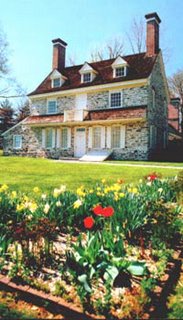
|
| Harriton House |
Three hundred years ago, in 1704, Roland Ellis acquired 700 acres of the Welsh Barony in what is commonly called Philadelphia Main Line and built a palatial house on it. He called his homestead Bryn Mawr, or great hill, after his ancestral home in Wales of the same name, thereby explaining why Bryn Mawr College and Bryn Mawr town have the name but are not notably situated on hills. The town of Bryn Mawr was once called Humphryville. But Bryn Mawr sounded nicer, even though there are plenty of Humphries still around to defend the older designation.
About fifty thousand acres were set aside by William Penn as the Welsh Barony, and there was the willingness to allow it to be self-governing, although that didn't much happens because the inhabitants saw no point in being self-governing. Nevertheless, the term isn't just an ethnic allusion, but has some historic meaning.
In any event, Ellis proved to be an unsuccessful manager of his estate, which rather soon passed into the hands of the Harrison family, who lived on it for about two hundred years until real estate development, and the taxes related thereunto, forced the creation of a complicated arrangement, with the township of Lower Merion owning the property and a non-profit group called the Harriton Association managing it. They have luckily obtained the services of a famous curator, Bruce Gill, who does research, writes papers, and organizes programs for visitors. The neighbors in the area, all living on land that formerly belonged to the Harrisons, are said to constitute the richest neighborhood in America. By building the original farmhouse rather far from the main road (Old Gulph) and remaining surrounded by neighbors who want to have privacy, Harriton House has fewer visitors than it deserves because it is so devilish hard to find.
There was a little local skirmishing during the Revolutionary War, but the main historical significance of the House was that Charles Thomson married a Harrison and lived there all throughout the period of the Revolution and the Articles of Confederation (1774-1789) as the Secretary of the Continental Congress. His little writing desk is, therefore, the most notable piece of furniture at Harriton House since every piece of official paper involved in the whole Revolutionary episode passed through it or over it. Modern organizations would do well to notice that Thomson was not given a vote and was expected to be totally unbiased about Congressional affairs. Even in those days, there must have been cautionary experience with secretaries who tinkered with the minutes for their own preferences. It certainly was entirely fitting that this last steward of the Articles of Confederation was designated to carry the news to George Washington at Mount Vernon, that he had been elected President of the new form of government. No doubt, Washington was pleased but unsurprised to learn of it.
While Harriton House is imposing on the exterior, and was the likely prototype of many characteristic Main Line stone mansions, the inside of the house is quite primitive. In those days it was cheap to build a big house but expensive to heat it. In 1704 surrounded by a continent of a forest, firewood may not have seemed a problem, but it quickly posed a transportation problem, and later houses tended to shrink in size. In any event, the interior of the house seems strangely bleak and bare, quite in keeping with the early Quaker principle of building a structure "without paint, or other adornments". Bruce Gill spent quite a lot of time and effort to determine that the random-width flooring had never received any shellac, varnish or wax. Those are beautiful floors, but the "finish" is just three hundred years of oxidized dirt.
The original Bryn Mawr, now called Harriton House, is well worth a visit. If you can find it; GPS is the modern solution.
Kenneth Gordon, MD, Hero of Valley Forge
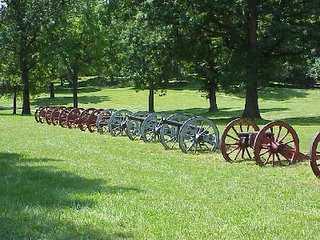
|
| Valley Forge |
There's no statue of Ken Gordon at Valley Forge National Park, although it would be appropriate. No building is named after him; it's probable he isn't even eligible to be buried there. But there would be no park to visit at Valley Forge without his strenuous exertions.
One day, Ken's seventh-grade daughter came home from school with the news that the father of one of her classmates said that Valley Forge Park was going to be turned into a high-rise development. That's known as hearsay, and lots of things you hear in seventh grade are best ignored. But this happened to be substantially true. At that time, the Park was owned by the Commonwealth of Pennsylvania, and Governor Shapp was finding the upkeep on the Park was an expense he needed to reduce. The historic area had two components, the headquarters area, and the encampment area. One part would become high-rise development and the other would become a Veteran's Administration cemetery. Although any form of rezoning has the familiar sound of politics to it, Dr. Gordon (a child psychiatrist) had the impression that Sharp was mostly interested in reducing state expenses, and had no particular objection to some better use of the historic area. At any rate, when Gordon went to see him, he said that he would agree to a historic park if Gordon could raise the money somehow. The Federal Government seemed a likely place to start.
Well, the sympathetic civil servants at the National Park Service told him how it was going to be. You get the consent of the local Congressman (Dick Schulze) and it will happen. If you don't get his consent, it won't happen. It seemed a simple thing to visit that Congressman, persuade him of the value of the idea, and it would be all done; who could refuse? After the manner of politicians, Schulze never did refuse, but somehow never got around to agreeing, either. It takes a little time to learn the political game, but after a reasonable time, the National Park employees told Gordon he was licked. Too bad, give up.
He didn't give up, he went to see his Senators, at that time Scott and Clark. They instantly thought it was a splendid idea, and instead of going pleasantly limp, they sent Citizen Gordon over to see Senator Johnson of Louisiana, the chairman of a relevant committee. Johnson also thought it was a great idea, and called out, "Get me a bill writer!" A bill writer is usually a government lawyer, tasked with listening to some citizen's idea and translating it into that strange language of laws -- section 8(34), sub-chapter X is hereby changed to, et cetera. Bill writers have to be pretty good at it, or otherwise, they will misunderstand the intent of the original idea, modified by the personal spin of the committee chairman, the comments of the authorizing committee, and later bargains struck in the House-Senate conference committee. Having negotiated all those hurdles, a bill has to be written in such a prescribed manner that it won't be found to have multiple loopholes when it later reaches the courts in a dispute. A good deal of the time of our courts is taken up with making sense of some careless wording by bill writers. That's what is known as the "Intent of Congress", an ingredient that may or may not survive the whole process.
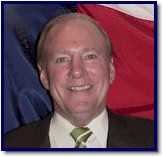
|
| Dick Schulze |
Ken Gordon had to go through this process, including testimony at hearings, for three separate congressional committees. To get everybody's attention, he organized several hundred supporters to write letters and get petitions signed by several thousand voters. These supporters, in turn, influenced the media and started a lot of what is known as buzz. All of this is an awful lot of work, but there is one thing about this case that can make us all proud. Not once did a politician suggest a campaign contribution was essential in this matter.
In time, ownership of the Park did in fact migrate from the Commonwealth to the U.S. Department of the Interior, hence to the National Parks Service. Everyone agrees it has been well managed, and increasing droves of visitors come here every year. It is now clearly a national treasure. Unfortunately, the encampment area got away and has been commercially developed, although not nearly as high-rise as originally contemplated. Along the way, many discouraging words were spoken about the futility of fighting against such odds. The outcome, however, is the embodiment of two slogans, the first by Ronald Reagan. "It's amazing what can be accomplished, if you don't care who gets the credit for it." The other slogan is older, and Quaker. All you need, to accomplish anything, is leadership. And leadership -- is one person.
One day Ken Gordon, the very busy doctor, was asked how much of his time was taken by this effort. His answer was, ten hours a week, every week for five years.
Potts
Rebecca Potts used to say there were three towns in Pennsylvania named after her family -- Pottstown, Pottsville,
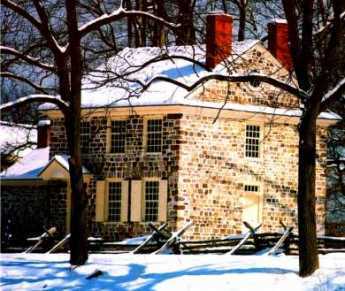
|
| Pottsville biennial |
and Chambersburg. Becky never designed to explain whether Chambersburg was just a joke or whether her very extensive family really had connections in Chambersburg. It's possible either way; there were certainly Potts inValley Forge where Washington's Headquarters, which everyone visits, had been home to Isaac Potts, the third generation of Dutchmen named Potts to live there. Isaac ran a grist mill, the others mostly were ironmasters. The family seat in Pottstown was named Pottsgrove, still open for visitors. Holland Dutch they may have been, but Pottsgrove architecture is definitely of the Welsh style.
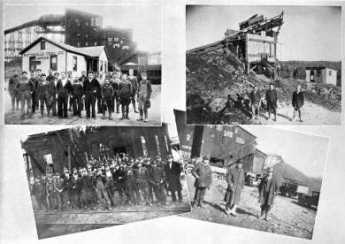
|
| Pottsville Coal |
Pottsville, much further up in the anthracite region, became notable through the novels of John O'Hara, a native son. For a whole generation, just about everybody in Pottsville was uneasy that O'Hara would confirm just who certain characters in his moderately raunchy novels represented in real life. Pottsville's main business for a century was extracting coal for the Girard Estate, which had its coal-mining headquarters in the town, based on Stephen Girard's shrewd purchase of nearly all of Schuylkill County.
The broad sweeping view from the interstate highway going north from Valley Forge makes it easy to see how Pottstown was created by the upheaval of a mountain ridge, which split open to let the Schuylkill River wind through. Pottstown is a water gap. The huge cooling towers of The Limerick nuclear power plant dominate one side of the river cliff and can be seen for miles. The cliff on the other side of the river, behind which hides the town of Pottstown, used to shelter the Wright aircraft factory, much of which was underground. That gave it a railroad (The Reading RR) and ready access to the river, plus privacy from the land side. Down to the right a mile is the Pottstown Hospital, on the edge of town, quite near the campus of the famous Hill School, fierce competitors of the Lawrenceville School in sports. Just about everything in this area is on top of some kind of hill.
Just back of the hospital, seemingly on the grounds of it, rises a peculiar steel tower, which the local workmen report is a sending station for cellular telephones. However, one of the doctors of the hospital relates a somewhat different history. He says he was once called on a medical emergency, told to ring the elevator at the little house beside the steel antenna, and travel down, down, into secret depths. He found himself in the headquarters of the Northeastern Air Defense Command, which was certainly hidden in an ideal place if the story has any truth to it. Unfortunately, that story-teller was a famous cocktail-party raconteur whose wild tales were never to be taken completely seriously. For many years, the hospital on a cliff was surrounded by corn fields, and it is certainly true you could look out the windows at a sea of corn, never suspecting you were very close to a railroad and a river, quite possibly right over an underground aircraft factory. Someday it may be possible to find out the truth of these tales of the Dutch country.
During the American Revolution, the British blockaded the coast and landed troops on the main coastal highways. The Americans responded in a quite natural way by building an inland north-south forest trail, sort of on the order of the Ho Chi Minh Trail. Pottstown was one natural stop on this trail, which tended to intersect with many roads coming up along the banks of the coastal rivers. In one very famous episode, wagon loads of Philadelphia Quakers were arrested and taken up the Schuylkill to Pottstown, then south to internment at Winchester, Virginia. They weren't exactly Tories, but they certainly were not sympathetic to revolutions. One of the most famous of these semi-prisoners was Israel Pemberton, one of the leaders of the Quaker colony. He later reported he was treated well, but onlookers in Pottstown described him as being thoroughly abused.
Pottstown had a century of prosperity during the industrial age, then declined and decayed. In recent years. The interstate highway has brought a migration of exurbanites whose taste in architecture tends toward McMansions. Let's hope they can acquire a dose of local history, starting a new historical revival of a town with great potential, considerable past glory, and a wonderful natural setting.
Radioactive River Bend
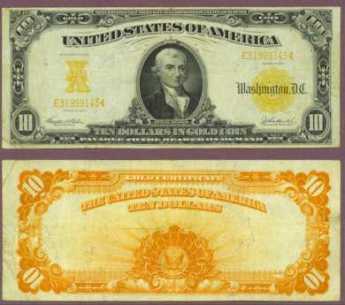
|
| Gold Cert |
A mile or two south of Pottstown, the Schuylkill River encounters a rocky ridge several hundred feet high and makes a bend around it. The first Treasurer of the United States, Michael Hillegas, built a colonial mansion on the point of the bend, and it has been lovingly restored and preserved by a noted Philadelphia surgeon and his wife. Alexander Hamilton, the first Secretary of the Treasury under the Constitution, has his picture on the modern version of a ten-dollar bill. So it is appropriate that Hillegas, the first Treasurer under the Articles of Confederation, had his picture on many versions of a ten-dollar gold note, back in the days when the American dollar was as good as gold. River Bend Farm is not only colonial, charming and maintained in mint condition, but it is also tucked away between the bend in the river and the high ridge to one side, giving it seclusion and privacy.
A high ridge near a river is unfortunately also an ideal place to build a nuclear power plant, and that's where the Limerick plant now looms up, glowing at night, occasionally making faint humming noises. There's a limited-access highway from Philadelphia to Reading which swoops up the valley, and the two high cooling towers of Limerick dominate the landscape for twenty miles. Because of the river bend, you aim straight for those towers for a long time before you swerve off, and the view is much like that from the bomber cockpit of the final scene in the movie "Dr. Strangelove". It gets your attention harmlessly, but it's hard to ignore. In spite of all sorts of official reassurance, everybody knows about Three-Mile Island, and Chernobyl, but few people emphasize there has never been a single injury from an American nuclear plant.
So, in 1981, everybody was ready to go into orbit when a worker named Watrus showed up for work at the nuclear plant and set off all manner of clanging alarms from radioactivity detectors. Panic and pandemonium for weeks, until a remarkable phenomenon was discovered. Watrus wasn't radioactive from the nuclear plant at all, but from having his work clothes laundered in his own basement. It slowly developed that radon gas seeps through the ground in many places in the United States, particularly over rocky ground. The gas then rises into the basement of houses and gets trapped. The more tightly the storm windows are applied and the more carefully sealed the seams of the house, the harder it is for the radon to escape. The Pennsylvania Dutchmen who live around Limerick are a little skeptical of this story and are not inclined to live any closer to the power plant that they have to. They are just as much in favor of oil self-sufficiency as anyone else, but still, no one likes being close to it.
The big winners from all this confusion are the people with radiation detectors, who go around the country testing people's basements for radon, for a fee. But unless you are willing to go live on the Sahara Desert, it isn't easy to see where you are going to go to avoid radon.
Lawn Tennis at the Cricket Club
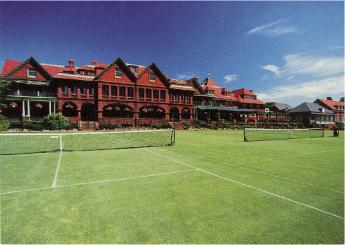
|
| Merion Cricket Club |
Lawn tennis isn't terribly ancient, having originated in England around 1880 as a variation of badminton which was brought back from India during the days of the British Empire. As the name suggests, it was originally played exclusively on grass courts, which proved hard to maintain. It was supplanted for a while by clay courts, and more recently by hard and artificial surfaces. Lawn tennis on lawns has largely become a game for the rich because of the cost and difficulty of maintaining a playable surface in hot weather.
If you wander into the Merion Cricket Club you'll find lawn tennis in the grand style, viewed from luncheon tables under a roofed porch. The long relatively narrow porch is right up against the grass courts, but it's also sort of a Peacock alley where well-groomed young ladies show their stuff, and everybody at the tables wishes to seem to know everyone else. There are times when the athletic entertainment becomes cricket out there on the field beyond the porch, but a larger proportion of the lunchers turn their backs on the field during that season than when exciting tennis championships are reaching the finals.

|
| "Lawn" Tennis |
In addition to being more expensive to maintain the courts, tennis on the grass is a different game from tennis on a hard surface, like clay or asphalt. The ball tends to skid when it hits the grass, so it is more effective to volley it before it hits or before it takes much of a bounce. The bounce tends to be more nearly straight up, while on harder surfaces the ball bounces at a low angle. Either way, the consequence is a tendency for a faster game on grass. The players run harder to get the ball at the bounce, and the advantage goes to those who serve hard and return the ball hard -- and fast.
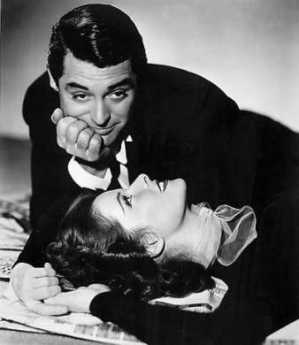
|
| Cary Grant and Kathryn Hepburn |
The rather special nature of the game adds to the up-scale atmosphere. And makes it just as attractive for the Kitty Foyles at the tables, as for the Kathryn Hepburns, both of whom have their own attractions for the Cary Grants. The parking lot is also a good place to form an opinion about the latest in high-priced autos.
www.Philadelphia-Reflections.com/blog/1494.htm
SEPTA's Long Term Planning
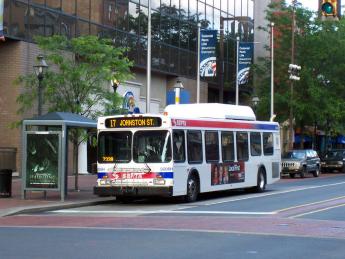
|
| Septa |
Byron S. Comati, the Director of Strategic Planning and Analysis for SEPTA (Southeastern Pennsylvania Transportation Authority), kindly gave the Right Angle Club an inside look at the hopes and plans of SEPTA for the near (five-year) future. Students of large organizations favor a five or six-year planning cycle as both short enough to be realistic, and long enough to expect to see tangible response. If plans continuously readjust to fit the five-year horizon, the concept is that the organization will move forward on these stepping stones, even accounting for setbacks, disappointments, and surprises. Furthermore, a serious level of continuous planning puts an organization in a position to react when funding opportunities arise, such as the sudden demand of the Obama Administration that economic stimulus proposals be "shovel ready."
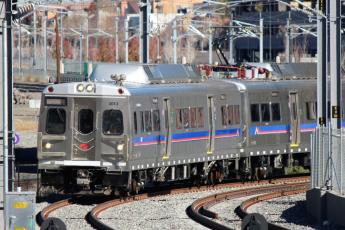
|
| The Silverline V |
So, SEPTA is currently promoting five major expansions, based on the emerging success of an earlier plan, the Silverliner V. Silverline is a set of 120 shiny new cars, built in Korea on the model of electrical multiple units, which are expected in Spring 2011 to replace 73 cars or units which were built in 1963. Obviously, 120 are more expensive than 73, but they are more flexible as well. And less wasteful; most commuters are familiar with the model of three seats abreast which unfortunately conflict with the social preferences of the public, tending to make the car seem crowded even though it is a third empty. When a misjudgment like this is made, it takes fifty years to replace it with something better. For example, there's currently a movement toward "Green construction", which is acknowledged to be "a little bit more expensive". The actual costs and savings of green construction have yet to become firmly agreed on, so there's an advantage to being conservative about what's new and trendy in things that take fifty years to wear out.

|
| Septa Regional Map |
Four of SEPTA's five major proposed projects are in the Pennsylvania suburbs. New Jersey has its own transportation authority, and Philadelphia is thus left to struggle with the much higher costs of urban reconstruction assigned to its declining industrial population. And left unmentioned is the six hundred pound gorilla of the transportation costs of new casinos. A great many people are violently opposed to legalized gambling, and even more upset by the idea of crime emerging in the neighborhoods of gambling enterprises. Even the politicians who enacted this legislation are uncomfortable to see the rather large expenditures which will eat into the net revenue from this development. Nevertheless, if you are running a transportation system, you have an obligation to plan for every large shift in transportation patterns, no matter what you might think of the wisdom of the venture. The alternative is to face an inevitable storm of criticism if casinos come about, but without any preparation having been made for the transportation consequences. At present, the public transportation plan for the casinos is to organize a light rail line along the Delaware waterfront, connecting to the rest of the city through a spur line west up Market Street; it may go to 30th Street Station, or it may stop at City Hall. That sounds a lot like the present Market-Frankford line, so expect some resistance when the cost estimates are revealed. Because all merchants want to have the station stops near them, and almost no residents want a lot of casino foot-traffic near their homes and schools, expect an outcry from those directions, as well. It would be nice to integrate this activity with something which would revive the river wards, but it seems a long stretch to connect with Wilmington on the south, or Trenton on the north.
The planned expansions in the suburban Pennsylvania counties will probably encounter less controversy, although it is the sorry fate of all transportation officials to endure some hostility and criticism for any changes whatever. Generally speaking, the four extensions follow a similar pattern of building along old or abandoned rail lines, following rather than leading the population migrations of the past. When you are organizing mass transit, there is a need to foresee with some certainty that there will be a net increase in commuters in the region under consideration. The one and two passenger automobile is a much more flexible instrument for adjusting to the growth of new development, schools, retail, and industry. Once the region has become established, there is room for an argument that transportation in larger bulk is cheaper, cleaner or whatever.
The Norristown extension follows the existing but underused rail connections to Reading. Route US 422 opened up the region formerly serving the anthracite industry, but now the clamor is rising that US 422 is impossibly crowded and needs to be supplemented with mass transit.
The Quakertown extension follows the rail route abandoned in 1980 to Bethlehem and Allentown, although the extension is only planned as far as Shelly, PA.
The Norristown high-speed extension responds to the almost total lack of public transportation to the King of Prussia shopping center, and will possibly replace the light rail connection to downtown Philadelphia.
And the Paoli extension follows the mainline Amtrak rails as far as Coatesville.
All of these expansions can expect to be greeted with huzzahs by developers, land speculators, and newsmedia, but resistance will inevitably be as fierce as it always is. Local business always fears an expansion of its competitors; the feeling is stronger in the suburbs than the city, but local business always resists and local politicians always follow their lead. To some extent, the suburbs have a point, since radial extensions are usually much cheaper to build than lateral or circumferential transportation media; bus routes are the favored pioneers in connecting one suburb with another. Therefore, the tendency in these present plans remains typical by threatening the suburbs with a need to travel toward the center hub, then take a reverse branch back in the general direction of where they started, in order to go a short distance to a shopping center or school system. The two main river systems around Philadelphia interfere with the construction of big "X" routes from the far distance in one direction to the far distance in the opposite direction. Euclidian geometry makes the circumferential route elongate as the square of the radius. And jealousies between the politicians in three states create rally foci for the special local interests which feel injured. Since it seems to be an established fact that the proportional contribution to mass transportation by the surrounding suburbs of Philadelphia is traditionally (and considerably) lower than the national average, a political reconciliation might do more for the finances of SEPTA than any federal stimulus package could do. For such reconciliation, a few lateral connections in the net might pacify the suburbs enough to justify the extra cost. Unfortunately, the main source of unjustified cost in regional mass transit is the high wage and benefit levels of the employees, a situation inherited from the old days when commuter rail was part of the stockholder-owned regional railroads. Just as featherbedding was the main cause of the destruction of the mainline railroads, health and pension benefits threaten the life of mass transit. In the old days, local governments acted as a megaphone for union demands. So the railroads just gave the commuter system to the local governments, and let them wrestle with the unions themselves. Since the survival of the urban region depends on conquering this financial drain, the problem must be gradually worn down. But it has been remarkable how long the region has been willing to flirt with bankruptcy rather than bite this bullet.
If anything, this friction threatens to get worse. In 2009, for the first time, a majority of union members in America -- work for the government, the one industry which thinks it cannot be destroyed by losing money. True, SEPTA is not exactly a government function, but it has enough in common with a government department to arouse suburban voters, who regularly refer to it as an arm of the urban political machine. SEPTA isn't too big to fail, but there exists little doubt that government at some level would probably try to bail it out if it did.
Short Tour of Philadelphia's West Country
 Philadelphia County had two hundred farms in 1950 but is now thickly settled in all directions. Western regions along the Schuylkill are still spread out somewhat; with many historic estates. 
|
| Dr. Fisher |
The Art Museum sits on an acropolis called Faire Mount, where William Penn planned to put his home. Fairmount Park, and hence the countryside, begins here and extends on both sides of the Schuylkill. It was once the industrialized terminus of barge traffic, but was restored to parkland as a water purification project in the Nineteenth Century after agitation by the College of Physicians of Philadelphia. The area was briefly a vast Civil War encampment, then the site of the 1876 Centennial, remnants of which remain. Its inner loop including the historic houses in the park is interesting enough to make a tour of its own; on this trip we just skirt the area.
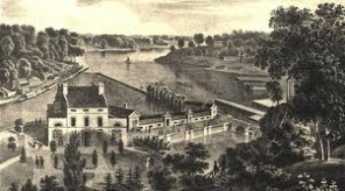
|
| Fairmount Park |
To begin the outer more general tour, go west over any one of the several Schuylkill bridges, turn right on 33rd Street in the general Drexel University/University of Pennsylvania area, observing many ancient mansions of a once-elegant place to live. Go past the Zoo, then up Belmont Avenue through the Centennial Grounds to City Line Avenue. Our first destination is Harriton, the original house in the Welsh Barony, called Bryn Mawr when it was built. Be sure to use a good map to find this large but hidden estate. It was the home of the first Secretary of the Continental Congress and its architecture set the style for the whole Main Line.
From here we carefully follow a map to the Barnes Museum in Merion. After acrimonious debates and clearly against Dr. Barnes' wishes, the vast collection of French Impressionist art is being moved to a new home on the Benjamin Franklin Parkway. Before it goes, you still have a chance to see the original concept in its intended setting.
From here we take a circuitous route to Germantown to see America's first suburb, with the Chew Mansion that cost Washington the battle of Germantown, Grumblethorpe, Stenton, and Schoolhouse Lane. A side trip to Temple University to see some portraiture if there is time, then down the Wissahickon Creek past Rittenhouse Town, eventually down Kelly Drive past the Schuylkill Navy, and over to the Art Museum (or alternatively the Water Works) for a nice lunch.
Benjamin Franklin Parkway (2)
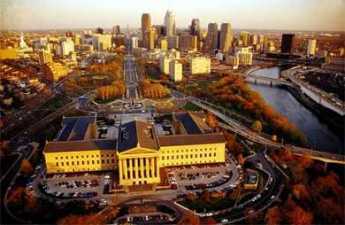
|
| Art Museum |
There are a number of residential relics along the Parkway, but in general the idea seems to have been to put governmental buildings there, in a sort of French-like celebration of governmental glory. There is the Youth Study Center, the Department of Education administration building, the Boy Scouts of America, the Cathedral of St. Peter and St. Paul, and of course the tower of City Hall at one end and the Parthenon-like Art Museum at the other. But this is Philadelphia, and certain small touches of the town are tucked among the European grandee design.
For example, WFLN (now WWFM) the original FM classical music station, had its studio tucked in a little building just behind the Cathedral. Ralph Collier would interview authors and city visitors there during the lunch hour, in a studio that was little more than a closet, while someone else changed records in a room downstairs. Somebody from New York once said that Ralph didn't seem to know how good he really was, which is a way New Yorkers like to talk. Ralph was, the just about the only interviewer who had actually read your book before the interview. In 1997, WFLN was sold for forty million dollars, which ought to impress even a New Yorker.
Logan Circle is bigger than it looks, primarily because the windows are set 100 feet high. This came about after the anti-catholic riots of the Civil War era, which made it advisable to put stained glass higher than most people can throw rocks. There is usually a cardinal in residence at this cathedral, and Cardinal Bevilacqua the much-respected lawyer-cardinal is now just retiring in favor of an incoming occupant from St. Louis. Cardinal Krol was famous in the past for his opposition to Pope John's Vatican Constitution, which he refused to allow to be translated into English. Before that, was Cardinal Dougherty, who is remembered for being considerably overweight. Cardinals are addressed as Your Eminence, and Cardinal Dougherty was (very privately) referred to as You're Immense. He was perhaps most famous for the Legion of Decency , an effort to make motion pictures more socially acceptable. The story is told of a 12-year-old girl who stood up and told the Cardinal that she didn't agree with him, she liked movies. The next day, her father, the most powerful Catholic banker in Philadelphia, had to go to the Cardinal and humble himself to make amends.
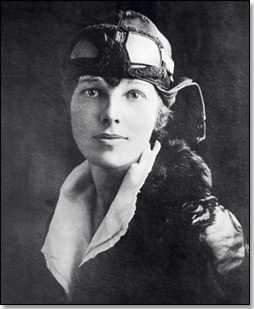
|
| Amelia Earhart |
Franklin Institute was originally on 7th Street, where the Atwater Kent Museum of Philadelphia History is now located. Much of the money to build it came from a $5000 bequest from Franklin himself, which was intended to demonstrate the power of compound interest over a period of time. It is part science museum, part memorial to Philadelphia's most famous citizen. It has a Planetarium, locomotive, a passenger airplane, Amelia Earhart's plane, a huge replica of a human heart, and thousands of working demonstrations of electrical phenomena. Ben Franklin's huge statue sits in a grand marble rotunda, where socialites occasionally hold receptions and weddings. But between the two extremes is the most interesting combination of museum and memorial -- a series of demonstrations of Franklin's most important scientific discoveries, utilizing the same instruments he used. Just a little effort at understanding these exhibits will convince any educated adult that Franklin was truly a genius.
Almost next door to the Franklin Institute is its more venerable neighbor, the Academy of Natural Sciences. The Academy is an offshoot of the American Philosophical Society, itself (originally founded by Franklin) and has a distinguished history of discovery and research of its own making, not merely a display of the work of others. Most school children will recognize the famous display of dinosaurs, including the First Dinosaur ever unearthed intact (in Haddonfield).
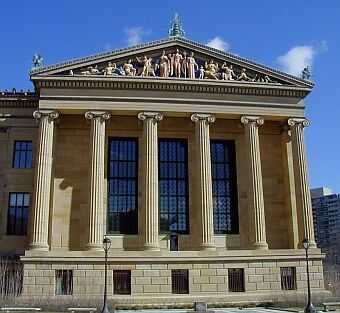
|
| Art Museum |
The Art Museum was intended to inspire awe, and it does. The builders ran out of money before the decorative friezes could be completed, but that even enhances its resemblance to the Parthenon, where the friezes were blown off in various wars. It's a little hard to know how to respond to the criticism that the building overwhelms its contents. Perhaps it is true that the creaking floorboards in Madrid's Prado Museum show off the treasures on its walls, but there is also little doubt that Spain (or Boston) would replace the floors if it could afford to. Although the City of Philadelphia has a little trouble finding the money to maintain and guard the Museum, the masonry is ultra-solid, it's very big, and will endure for ages to come. The collections slowly grow, benefaction by benefaction. The traveling exhibits are clearly the center of Philadelphia culture. And there, at the top of the stairs without any clothes on, is Diana of fame and fable. Her perfectly straight back is the true essence of the famously beautiful Philadelphia woman, like Fannie Kemble, Rebecca Gratz, Evelyn Nesbitt,Cornelia Otis Skinner, Grace Kelly, and Katherine Hepburn.
Contemporary Germantown
The Strittmatter Award is the most prestigious honor given by the Philadelphia County Medical Society and is named after a famous and revered physician who was President of the society in the 1920s. There is usually a dinner given before the award ceremony, where all of the prior recipients of the award show up to welcome to this year's new honoree.
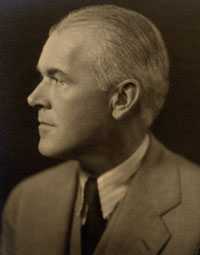
|
| Bockus |
This is the reason that Henry Bockus and Jonathan Rhoads were sitting at the same table, some time around 1975. Bockus had written a famous multi-volume textbook of gastroenterology which had an unusually long run because it was published before World War II and had no competition during the War or for several years afterward; to a generation of physicians, his name was almost synonymous with gastroenterology. In addition, he was a gifted speaker, quite capable of keeping an audience on the edge of their chairs, even though after the speech it might be difficult to recall just what he had said. On this particular evening, the silver-haired oracle might have been just a wee bit tipsy.
Jonathan Rhoads had likewise written a textbook, about Surgery, and had similarly been president of dozens of national and international surgical societies. He devised a technique of feeding patients intravenously which has been the standard for many decades, and in his spare time had been a member of the Philadelphia School Board, a dominant trustee of Bryn Mawr and Haverford Colleges, and the provost of the University of Pennsylvania. Not the medical school, the whole university, and is said to have been one of the best provosts of the University of Pennsylvania ever had. When he was President of the American Philosophical Society, he engineered its endowment from three million to ten times that amount. For all these accomplishments, he was a man of few words, unusual courtesy -- and a huge appetite in keeping with his rather huge farmboy physical stature. On the evening in question, he was busy shoveling food.
"Hey, Rhoads, wherrseriland?". Jonathan's eyes rose to the questioner, but he kept his head bowed over his plate.
"HeyRhoads, Westland?" The surgeon put down his fork and asked, "What are you talking about?"
"Well," said Bockus, "Every famous surgeon I know, has a house on an island, somewhere. Where's your island?
"Germantown," replied Rhoads, and returned attention to his dinner.
Donor Intent
At least three of the greatest treasures of Philadelphia are now used in ways that almost certainly flout the expressed wishes of the donor. Steven Girard's
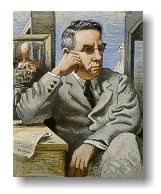
|
| Alfred Barnes |
bequest for the enhancement of "poor, white, orphan boys" is now devoted mostly to black children, many of the girls, many of them non-poor by some definitions, and many of them orphans only in a limited sense. Alfred Barnes wanted his art treasures to be used for education, outside the city of Philadelphia which had offended him, and definitely not part of the Philadelphia Museum of Art which he disliked. They are now to be moved to Philadelphia's Parkway, close to and under the thumb of, the Philadelphia Museum of Art. John G. Johnson's immense art collection now resides within the Museum of Art in spite of the firm declaration by this eminent lawyer that it was to remain in his house, and definitely not to be used to promote some huge barn of a museum.
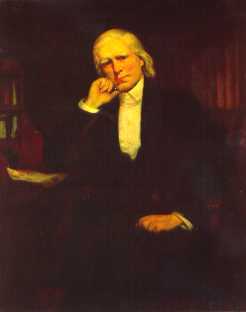
|
| William J Duane |
It's hard to imagine how any set of instructions could be devised to be more clear than these. Barnes employed a future Supreme Court Justice, Owen Roberts, to write his will. Girard similarly employed the preeminent counsel of his time, William J. Duane, to devise an extraordinarily detailed set of instructions. John G. Johnson was himself considered to be the most eminent lawyer in the city. In fact, he once received a fee of $50,000 for his opinion about a corporate financial plan, consisting of the single word "No" scrawled on its cover.
It would be interesting to know whether these famous cases are typical of the way wills are treated, either in this city or in the nation generally. Perhaps they are notorious mainly because they are so unusual. But perhaps they are indeed rather representative and stand as lurid examples of the general failure of the rule of law. Perhaps they reflect some deeper wisdom of the law, where Oliver Holmes intoned that the standard was not logic, but experience.
<Perhaps some guidance can be found in the decisions of Lewis van Dusen, Sr. who for several decades established the Orphans Court of Philadelphia as a model for the world to follow. Someone seems to have thought he set a good example. But was his reign an exception, or a glowing example of the triumph of society's wisdom over the crabbed grievances of dying millionaires in their dotage?
These remarks are made while the newspapers are filled with the story of a Texas billionaire who married a magazine model fifty years younger than himself. Some prominent local heiresses are known to have run off with their stable boys. Indeed, you don't need to read many tabloids to see a dozen examples of such behavior. Is it possible that some of them were acting up out of frustration at the probable betrayal by the courts of more reasoned instructions for their wealth?
East Falls
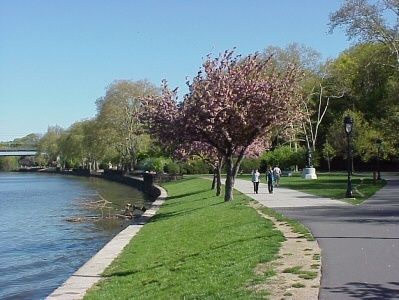
|
| Kelly drive |
The views along the charming, curving, leafy East River Drive from the Art Museum to the (former) Falls of the Schuylkill are dominated by rowing and the rowing clubs, so it isn't surprising that Philadelphia's most famous oarsman, John B. Kelly, used to live in East Falls, the residential area just at the end of the rowing area. I was once sent to see him by a mutual acquaintance when we were considering buying a house in his neighborhood. "East Falls," he said, will remain a nice place as long as I am alive but not longer than that." He might have added the names of Connie Mack(Cornelius McGillicuddy) the fifty-year owner and manager of the Philadelphia Athletics who lived on Schoolhouse Lane, and Harry Robinhold, who lived on Warden Drive and was the only real estate agent who ever seemed to have properties available in the area. But the friendly warning that Kelly was intoning seemed quite plausible, and we didn't buy the house.

|
| Roosevelt Blvd. |
There seems to be no question that Frank Sinatra and Ava Gardner were married in Philadelphia in November 1951 and that Jimmy Duffy did the catering. It's only hearsay, strongly asserted, that the wedding took place in a big white house at the corner of School House Lane and Henry Avenue. That would, I believe, be the house where Connie Mack the baseball team owner and manager, lived. Just what connection these movie stars had with Connie, or with Grace Kelly who lived a block away, is undocumented but strongly suggested.
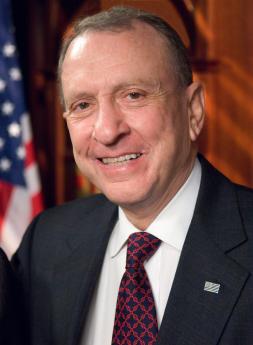
|
| Arlen Specter |
Decades later, however, East Falls continues to be a curious little cluster of three thousand houses, very close to the center of town but leafy and suburban, surrounded by other neighborhoods which underwent serious urban decay long ago. The Wissahickon Valley on one side,Roosevelt Expressway on a second, and the Schuylkill River on a third give it physical isolation, and the brow of the hill is held apart from West Germantown by a couple of large schools and college campuses. Even the strip of small commercial businesses along East River Drive serves to discourage random wanderers. But that's just as true further East along the comparable strip near the Delaware, where it doesn't have the same result.
More likely, the fact that so many judges and politicians live there (the list includes Mayor Governor Rendell and Senator Specter) guarantees police protection of a high order, and probably also makes inconvenient government construction, or regulation, highly unlikely. The local school is good, the local private schools are even better. If you are ever seeking to improve local residential amenities (and real estate values), you ought to study what it is that enhances East Falls, and quietly act on your discoveries.
East Park Jingle
T he Paoli Local makes so many stops from 69th Street to Paoli, and those suburban stops look so much alike, that a dozing passenger can suddenly realize that he doesn't know whether he's gone past his intended stop or not. The conductor may shout out the station, but is it before, or after? To help with this problem, some wag composed a little jingle --"69 Old Maids Never Wed And Have Babies", which helps remember 69th street, Overbrook, Merion, Narberth, Wynnewood, Ardmore, Haverford, Bryn Mawr. There's more to the jingle for further stops, but it gets a little raunchy. And anyway, Bryn Mawr students get off at The College, so further stations are safely ignored.
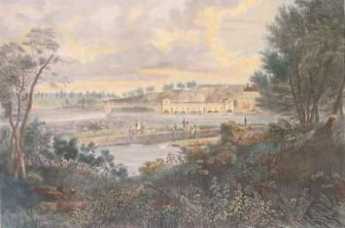
|
| Fairmount Park |
In view of the success of the Main Line jingle, it is tempting to compose small doggerel to assist remembering the forty or so points of interest in Fairmount Park. The old Park Trolley line stopped running in 1946, so we must look further for a logical modern sequence. Marion W. Rivinus has provided an ideal model in her charming little book "Lights Along the Schuylkill", now unfortunately out of print. The charming book contains a succession of sketches and comments about the houses and history of Fairmount Park. The book kindly begins and ends with a map of the park, the locations all numbered, in a sequence which is a perfectly acceptable guide to a complete tour by today's roads. There are a dozen acceptable ways you might wander around the Park, but to see everything would take a week and so for anyone to follow Mrs. Rivinus' tour precisely is improbable anyway. Nevertheless, her numbered sequence, without ever saying so, is the suggested itinerary of someone who knows and loves the park better than anyone. Since several members of her family were members of the original Park Commission, she comes by it all by inheritance, She's very small, and very sprightly, quickly dominates any group who are visiting one of the Park Houses for a party, and has lots and lots to say. She surely will not be offended to have it generalized that her age is North of 80; if she wants to adjust that statistic further, you will have to ask her. Philadelphia really needs to have her book republished.
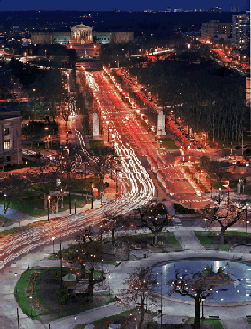
|
| Benjamin Franklin |
So, begin at the Art Museum with the portion of the park which is on the East side of the Schuylkill. The jingle we offer begins "An Eager Walker Brings Hot Chocolate" (Art Museum, Eakins Oval, Water Works, Boat House Row, Lemon Hill, Cliffs) for the visible and famous anchor of the Park, the culmination of the rather grand promenade of the Benjamin Franklin Parkway. Notice first the general lay of the land.

|
| City Hall |
The motorist driving West from City Hall starts to weave through traffic and then starts to careen around curves of the East River Drive, now called Kelly Drive. Absorbed in the intricacies of urban driving, the motorist often fails to look up to the right and notice that he is really driving past the end of an elevated plateau. The cliff end rises sharply enough that the modern commuter often does not realize how short a distance to the right it is to quite another world. The river makes two right-angle turns, with a large lake or reservoir along the top of the first point. The East Park Reservoir covers about twenty-five square blocks of land, with colonial-era houses along the river rim, and the very dense urban area stretching off on the other side of the reservoir. The western edge of the forty-five acres of Girard College comes pretty closes to the edge of the park. If you drive from the edge of the cliff overlooking the Schuylkill, around the reservoir, and then down the side wall of Girard College, it is quite a shock to go from 18th Century mansions, woods, and pastures suddenly into what cannot honestly be called anything but a slum. A huge teeming slum, that seems to stretch on, forever. But back at Laurel Hill on the western edge, you walk a few steps from the road to the front door; if you walk straight through to the back porch, it is only fifteen steps from a spectacular view of the wooded river valley, and the edge of a very steep cliff. Although the Randolph family lived here and gave it the current name, Laurel Hill was the country seat of the Rawle family, which also graces the name of the oldest law firm in the country.
The southern end of this central north-south ridge of Philadelphia is now called Lemon Hill. It was the site of William Penn's intended manor house, until he later relocated to Pennsbury, up near Trenton. In time 300 acres of the area became -- by way of Tench Francis -- the country home of Robert Morris, probably the richest man in America and masterful financier of the Revolution. There is little question The Hill became the most glamorous social center in America, with George Washington staying overnight many times, and Martha Washington becoming a firm fast friend of Robert Morris' wife Molly White Morris, sister of William White, first Episcopal Bishop in America. It's true there were real lemon trees on The Hills, also true the estate was sold at sheriff's sale when Morris got thrown into debtor's prison for three years. The cause of his financial collapse was not the Revolutionary War, but overzealous speculation in real estate in the District of Columbia when it was decided (against his loud objections) to move the Nation's capital to the swamps of the Potomac. Morris was a great patriot for his country and his city, but he was also a bold and reckless speculator. Eventually, it caught up with him. Since the loss of the Capital was the greatest defeat Philadelphia ever experienced, it could easily be supposed the judges of his bankruptcy were unsympathetic with his attempt to profit from the deal.
There is only a thin shelf of land, scarcely wide enough for the East River Drive, at the foot of the cliff from the Water Works to the Wissahickon Creek, so most of the interesting houses are up at the top of the ridge. It is all a driver can do to stay on the twisting road and notice Boat House Row, with skulls on the river, without looking up to the right to see what's interesting. Many of the houses, like Woodford of William Coleman (Ben Franklin's lawyer). Laurel Hill of Francis Rawle, Mount Pleasant that was almost sold to Benedict Arnold, the Thompson family's federalist mansion called Rockford, and Charles Thompson's Somerton, later acquired by Judge William Lewis and now called Strawberry Mansion, were homes of prominent leaders of the American Revolution. Other houses in the neighborhood belonged to Tories. The Franks of Woodford almost became Arnold's neighbors while David Franks was smuggling letters to Major Andre, Joseph Galloway was Provost Marshall of Philadelphia during the British occupation, so his home, Ormiston, was confiscated when he left town along with General Howe. Two houses were moved to the premises, sort of destroying the dream of the preservationists to have it just the way it once was. Although Hatfield House was built in 1760, it was originally on Hunting Park Avenue and moved, stone by stone, to Fairmount Park in 1930 at the expense of the Hatfield family. And finally, Grant's Cabin. It's really pretty interesting to see the two-room cabin where General and Mrs. Grant lived for five months, overlooking the James River while Grant was concluding his campaign that led to surrender at Appomattox, issuing orders to Sherman and Sheridan, and receiving the visits of Lincoln, Meade and the Confederate Commissioners suing for peace. It's highly interesting to have Grant's headquarters displayed in our park, but, well, it seems a little out of place if you know what place you are visiting.
Let's extend our little doggerel. It begins with "An Eager Walker Brings Hot Chocolate;" and goes on "Most real Olympic runners won't stop." That's Mount Pleasant, Rockland, Ormiston, Randolph, Woodford, and Strawberry Mansion.
Fairmount Park Historic Preservation Trust
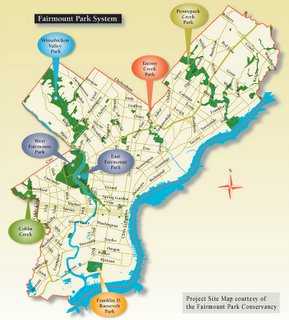
|
| Philadelphia's Fairmount Park |
New York's Central Park was created when it became clear there would be no park unless it was deliberately planned and its boundaries vigorously defended against real estate developers. Philadelphia's Fairmount Park, on the other hand, was to some degree a slum clearance project. The swift waters of the Wissahickon provide excellent power sources, provoking the construction of many mills. With steam power, they were abandoned, leaving desolate industrial hulks that blotted the landscape. Fairmount Park cleared out the remains of deserted mills, which had moved upriver to Manayunk, closer to a supply of coal. Fairmount Park was a creation of the Pennsylvania State Legislature, but the State never funded it. And it has thus always been somewhat larger than the City could afford.
In the early 1990s a beleaguered City government reached a public/private accord as a result of a commissioned study of the matter, which essentially urged that the city government should run the recreational programs in the parking area, and the private sector should be asked to do its best with land and historic building preservation. The William Penn Foundation, the Pew Charitable Trusts, and other philanthropic organizations banded together to form the Fairmount Park Historic Preservation Trust. Among its functions was to coordinate the many organizations which had been formed to preserve small areas of the park, as a result of the concerns of neighborhoods or descendants of former owners of historic homes. The Fairmount Park Trust finds itself in charge of over 400 houses, of which about 250 are genuine of historic value. They have to be preserved against vandalism and vagrants, mainly they have to be preserved against decay. Someone has to use them, and for that, someone has to spend money to fix them up and maintain them. If that is to happen, someone else has to set standards for preservation that balance the historic values with the need for some kind of present usage. Since few people would be willing to spend money and put up with uneconomical regulations if the building belongs to the park, the management of the Trust must manage and oversee very long-term leases. Obviously, the Trust must know what it is doing, have the wisdom to be innovative, and endure a fair amount of harangue by disappointed developers.
And it must supply some things which are hard to find, like advice and know-how about fixing up historic buildings of a certain age and history. The Trust has actually gone into the business of doing historic preservation for a fee, on its own property and elsewhere (Christ Church burial ground is an example). It thus generates some income to supplement philanthropic contributions. There is no requirement that prospective tenants must be non profit, only that the entity be of value to the neighborhood, and there are other signs that the Trust intends to be far-sighted and imaginative in the goal of making the Park something to be proud of, from the nearest to the farthest corner.
One idea suggested for further coordinated action might be to search for types of underbrush which would be repellent to deer who destroy the forest understory. Or, to search for particularly tasty "bait" shrubs which would draw the deer away from areas needing preservation. The combination of both ideas might lead to a natural balance, which would be unlikely to come about by the action of small local preservationists. Meanwhile, there are too many deer, and someone has to decide how and when to "cull the herd". That's how, in a small way, the trust got into the venison business.
So far, the Trust has preserved about 25 houses in the past ten years. That's a marvelous achievement, but it will take a century to complete the whole park unless momentum picks up. The Trust sort of needs an impresario of some kind or other to stir up public support.
Encampment At East Falls
The urban intersection at Queen Lane and Fox Avenue in East Falls is a busy one, and except for a few stately residences, it easily escapes notice by commuters. However, the landscape forms a bowl atop a steep hill, fairly near the Schuylkill River. George Washington had evidently picked it out as a strong military position near the Capital at Philadelphia, either to defend the city or from which to attack it, as circumstances might dictate.
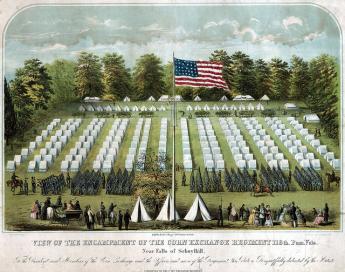
|
| Encampment at East Falls |
Washington's plans and thought processes are not precisely recorded, but when Lord Howe had sailed south from the Staten Island- New Brunswick area, he ordered his troops to head for an East Falls encampment at the southern edge of Germantown. Crossing the Delaware River at Coryell's Ferry (New Hope), the troops marched inland a few miles and then down the Old York Road to this encampment. Their stay at the beginning of August 1777 was quite brief because Washington changed his mind. When it took Howe's fleet longer than expected to appear in the Chesapeake, Washington became uneasy that Howe might be conducting a feint designed to draw the Continental troops south, and after cruising around the coast, might still return to attack down the undefended New Jersey corridor from Perth Amboy to Trenton. That proved wrong, but in Washington's defense, it must be said it was a plan that had actually been considered by the British. Anyway, Washington ordered his troops to pull out of the East Falls encampment and march back up Old York Road to Coryell's Crossing, which would be a more central place to keep his options open for the time when Howe's true intentions became clear. Washington and his headquarters staff went on ahead of the main body of troops, setting up headquarters at John Moland's House a little beyond Hatboro and a few miles west of Newtown, Buck's County. The Hatboro area was a pocket of Scotch-Irish settlement, without any local Tory sentiment, thus preferable to the rest of largely Quaker Buck's County.
To jump ahead chronologically, the East Falls encampment site must have seemed agreeable to the Continental Army, because a few weeks later it would be sought out as the main refuge and regrouping area, following the defeat at the Battle of Brandywine. The American troops were to withdraw from the Brandywine Creek when Washington realized he had been out-flanked, and head for Chester. Quickly recognizing that Chester was vulnerable, they headed for East Falls. Not only was Washington preparing to defend Philadelphia at that point, but was using the Schuylkill River as a defense barrier. As he had earlier done at the Battle of Trenton, he ordered all boats removed from the riverbanks, and artillery placed at any likely fording places, all the way up the Schuylkill to Norristown. Having accomplished that, this extraordinary guerrilla fighter then moved his troops from Germantown up the river to defend the fords. Meanwhile, Congress decided to move to the town of York on the Susquehanna, just in case.
Germantown After 1730
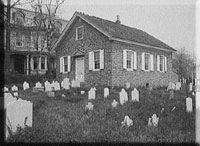
|
| German Quaker Home |
The early settlers of Germantown were Dutch or German-speaking Quakers. They were proud of the craftsman class but, unfortunately, that made them rather poor subsistence farmers. With a whole continent stretching beyond them, professional farmers would not likely choose to settle on a stony hilltop, two hours away from Philadelphia. Germantown's future lay in religious congregation, in papermaking, textile manufacture, publishing, printing and newspapers. Plenty of stones were lying around, so stone houses soon replaced the early wooden ones. Since Philadelphia in 1776 had only twenty or so thousand inhabitants, and only thirty wheeled vehicles other than wagons, it was not too difficult for Germantown to imagine it might eventually eclipse that nearby seaport full of Englishmen. Two wars and two epidemics brought those Germantown dreams to an end, but in a sense, those calamities were stimulants to the town, as well.
In 1730 real German peasants began to arrive in large numbers from the Palatinate section of the Rhine Valley. They arrived as survivors of a horrendous ocean sailing experience, packed in such density that it was not unusual to find dead bodies in the hold, of passengers that had only been supposed to have wandered into a different part of the ship. Quite often, they paid for their passage by selling themselves into what amounted to limited-time slavery, and a customary pattern was for parents to sell an adolescent child into slavery for eight or ten years in order to pay for the voyage of the family. They were uneducated, even ignorant, and often were proponents of small new religious sects. All of that made them seem to be a primitive tribe in the eyes of the earlier settlers. But they were professional farmers, and good at it. They knew, and a quick tour of Lancaster County today confirms their belief, that if you had a reasonable amount of very good land, you could live a life that approached that of the craftsmen in comfort, and usually far exceeded them in personal assets. They have therefore taken a long time to rise from farm to sophistication, while the already sophisticated craftsmen in Germantown wasted no time in abandoning farming. The peasant newcomers arrived in Philadelphia, made their way to nearby Germantown, learned a little about the new country and the refinements of their Protestant culture -- and then pressed on to the great fertile valley to the West, where the way had been paved by those twenty-five German families who had landed on the Hudson River several decades earlier and come down the Susquehanna via Cooperstown. Only a minority of the after-1730 Germans stayed on permanently in that steadily growing little German metropolis on a hill, and none of the very earliest German pioneers further west had even landed in Philadelphia.
During this period, this Athens of German America also invented the Suburb. The pioneer of this concept was Benjamin Chew, the Chief Justice, who built a magnificent stone mansion on Germantown Avenue, which was to become the main fortress of the Battle of Germantown in the Revolutionary War. Present-day visitors are still impressed with the immensity and sturdy mass of this home. Grumblethorpe, Stenton and a score of other country homes were placed there. Germantown in 1750 still wasn't a very big town, but it was plenty comfortable, quiet, safe, intellectual and affluent. Its first disruption came from the French and Indian War.
Germantown and the French and Indian War
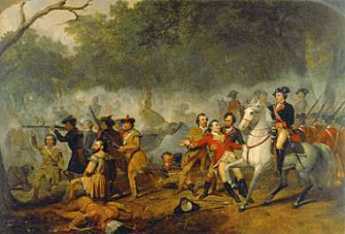
|
| The survivors of General Braddock's defeated army |
Allegheny Mountains from which to trade with, and possibly convert the Indians, the French had a rather elegant strategy for controlling the center of the continent. It involved urging their Indian allies to attack and harass the English-speaking settlements along the frontier, admittedly a nasty business. The survivors of General Braddock's defeated army at what is now Pittsburgh reported hearing screams for several days as the prisoners were burned at the stake. Rape, scalping and kidnapping children were standard practice, intended to intimidate the enemy. The combative Scotch-Irish settlers beyond the Susquehanna, which was then the frontier, were never terribly congenial with the pacifism of the Eastern Quaker-dominated legislature. The plain fact is, they rather liked to fight dirty, and gouging of eyes was almost their ultimate goal in any mortal dispute. They had an unattractive habit of inflicting what they called the "fishhook", involving thrusting fingers down an enemy's throat and tearing out his tonsils. As might be imagined, the English Quakers in Philadelphia and the German Quakers in Germantown were instinctively hesitant to take the side of every such white man in every dispute with any redone. For their part, the Scotch-Irish frontiersmen were infuriated at what they believed was an unwillingness of the sappy English Quaker-dominated legislature to come to their defense. Meanwhile, the French pushed Eastward across Pennsylvania, almost coming to the edge of Lancaster County before being repulsed and ultimately defeated by the British.
In December 1763, once the French and Iroquois were safely out of range, a group of settlers from Paxtang Township in Dauphin County attacked the peaceable local Conestoga Indian tribe and totally exterminated them. Fourteen Indian survivors took refuge in the Lancaster jail, but the Paxtang Boys searched them out and killed them, too. Then, they marched to Philadelphia to demand greater protection -- for the settlers. Benjamin Franklin was one of the leaders who came to meet them and promised that he would persuade the legislature to give frontiersmen greater representation, and would pay a bounty on Indian scalps.
Very little is usually mentioned about Franklin's personal role in provoking some of this warfare, especially the massacre of Braddock's troops. The Rosenbach Museum today contains an interesting record of his activities at the Conference of Albany. Isaac Norris wrote a daily diary on the unprinted side of his copy of Poor Richard's Almanac while accompanying Franklin and John Penn to the Albany meeting. He records that Franklin persuaded the Iroquois to sell all of western Pennsylvania to the Penn proprietors for a pittance. The Delaware tribe, who really owned the land, were infuriated and went on the warpath on the side of the French at Fort Duquesne. There may thus have been some justice in 1789 when the Penns were obliged to sell 21 million acres to the Commonwealth of Pennsylvania for a penny an acre.
Subsequently, Franklin became active in raising troops and serving as a soldier. He argued that thirteen divided colonies could not easily maintain a coordinated defense against the unified French strategy, and called upon the colonial meeting in Albany to propose a united confederation. The Albany Convention agreed with Franklin, but not a single suspicious colony ratified the plan, and Franklin was disgusted with them. Out of all this, Franklin emerged strongly anti-French, strongly pro-British, and not a little skeptical of colonial self-rule. Too little has been written about the agonizing self-doubt he must have experienced when all of these viewpoints had to be reversed in 1775, during the nine months between his public humiliation at Whitehall, and his sailing off to meet the Continental Congress. Furthermore, as leader of a political party in the Pennsylvania Legislature, he also became vexed by the tendency of the German Pennsylvanians to vote in harmony with the Philadelphia Quakers, and against the interest of the Scotch-Irish who were eventually the principal supporters of the Revolutionary War. It must here be noticed that Franklin's main competitor in the printing and publishing business was the Sower family in Germantown. Franklin persuaded a number of leading English non-Quakers that the Germans were a coarse and brutish lot, ignorant and illiterate. If they could be sent to English-speaking schools, perhaps they could gradually be won over to a different form of politics.
Since the Germans of Germantown was supremely proud of their intellectual attainments, they were infuriated by Franklin's school proposal. Their response was almost a classic episode of Quaker passive-aggressive warfare. They organized the Union School, just off Market Square. It was eventually to become Germantown Academy. Its instruction and curriculum were so outstanding as to justify the claim that it was the finest school in America at the time. Later on, George Washington would send his adopted son (Parke Custis) to school there. In 1958 the Academy moved to Fort Washington, but needless to say, the offensive idea of forcing the local "ignorant" Germans to go to a proper English school was rapidly shelved. This whole episode and the concept of "steely meekness" which it reflects might be mirrored in the Japanese response, two centuries later, to our nuclear attack. Without the slightest indication of reproach, the Japanese wordlessly achieved the reconstruction of Hiroshima as now the most beautiful city in the modern world.
Germantown Before 1730
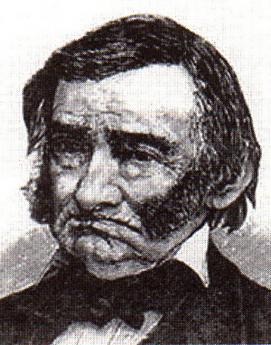
|
| Rev. Wilhelm Rittenhausen |
The flood of German immigrants into Philadelphia after 1730 soon made Germantown, into a German town, indeed. From 1683 to 1730, however, Germantown had been settled by Dutch and Swiss Mennonites, attracted by the many similarities between themselves and the Quakers of England. They spoke German dialects to preserve their separateness from the English-speaking majority but belonged to distinctive cultures which were in fact more than a little anti-German. This curiosity becomes easier to understand in the context of the mountainous Swiss burned at the stake by their Bavarian neighbors, Rhinelanders who sheltered them from various warring neighbors, and Dutchmen at the mouth of the Rhine, all adherents of Menno Simon the Dutch Anabaptist, but harboring many differences of viewpoint about the tribes which surrounded them.
Anabaptism is the doctrine that a child is too young to understand religion, and must be re-baptized later when his testimony will be more binding. In retrospect, it seems strange that such a view could provoke such antagonism. These earlier refugees were often townspeople of the artisan and business class, rapidly establishing Germantown as the intellectual capital of Germans throughout America. This eminence was promoted further through the establishment by the Rittenhouse family (Rittinghuysen, Rittenhausen) of the first paper mill in America. Rittenhousetown is a little collection of houses still readily seen on the north side of the Wissahickon Creek, with Wissahickon Avenue nestled behind it. The road which now runs along the Wissahickon is so narrow and windy, and the traffic goes at such dangerous pace, that many people who travel it daily have never paid adequate attention to the Rittenhousetown museum area. It's well worth a visit, although the entrance is hard to find (try going west on Wissahickon Avenue then turning around, a little beyond the entrance).
Even today, printing businesses usually locate near their source of paper to reduce transportation costs. North Carolina is the present pulp paper source, several decades ago it was Michigan. In the Seventeenth and Eighteenth centuries, paper came from Germantown, so the printing and publishing industry centered here, too. When Pastorius was describing the new German settlement to prospective immigrants, he said, "Es ist nur Wald" -- it's just a forest. A forest near a source of abundant water. Some of the surly remarks of Benjamin Franklin about German immigrants may have grown out of his competition with Christoper Sower (Saur), the largest printer in America, and located of course in Germantown.
Francis Daniel Pastorius was sort of a local European flack for William Penn. He assembled in the Rhineland town of Krefeld a group of Dutch Quaker investors called the Frankford Company. When the time came for the group to emigrate, however, Pastorius alone actually crossed the ocean; so he was obliged to return the 16,000 acres of Germantown, Roxborough and Chestnut Hill he had been ceded. Another group, half Dutch and half Swiss, came from Krisheim (Cresheim) to a 6000-acre land grant in the high ground between the Schuylkill and the Delaware. The time was 1683. The heavily Swiss origins of these original settlers give an additional flavor to the term "Pennsylvania Dutch".
Where the Wissahickon crosses Germantown Avenue, a group of Rosicrucian hermits created a settlement, one of considerable musical and literary attainment. The leader was John Kelpius, and upon his death the group broke up, many going further west to the cloister at Ephrata. From 1683 to 1730 Germantown was small wooden houses and muddy roads, but there was nevertheless to be found the center of Germanic intellectual and religious ferment. Several protestant denominations have their founding mother church on Germantown Avenue, Sower spread bibles and prayer books up and down the Appalachians, and even the hermits put a defining Germantown stamp on the sects which were to arrive after 1730. The hermits apparently invented the hex signs, which were carried westward by a later, more agrarian, German peasant immigration, passing through on the way to the deep topsoil of Lancaster County.
La Fayette, We Are Here
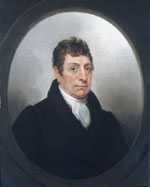 |
| Gilbert du Motier, marquis de La Fayette |
It will be recalled that La Fayette was 19 years old at Valley Forge, spoke no English, had no previous military experience. He nevertheless demanded, and got, a commission as Major General on the prudent condition that he have no troops under his command, at least for a while. Washington had been strongly reminded by various people that this young Frenchman was one of the richest men in France, a personal friend of the Queen, and thus critical to the project of enlisting French assistance in the war. Under the circumstances, it was shrewd to send him on the project of enlisting Indian allies among the Iroquois, since many tribes, particularly the Oneida, spoke French and held their former allies in the French and Indian War in great esteem. The chief of the Oneida Wolf clan (Honyere Tiwahenekarogwen) was visiting General Philip Schuyler in Albany at about the time LaFayette showed up on his mission to get some help for Valley Forge. General Horatio Gates was busy at the time rallying a colonist army to defend against the British under Burgoyne, coming down from Quebec, eventually to collide at the Battle of Saratoga.
Earlier in the war, Honyere's Oneida tribe had tangled with their fellow Iroquois under the leadership of Joseph Brandt (the Dartmouth graduate who was both biblical scholar and commander of several frontier massacres); the Oneida had many new scores to settle with the English-speaking Iroquois tribes. Honyere made the not unreasonable request that before his warriors went off to war, his new American allies would please build a fortification to protect his women and children from Brandt's Mohawks. LaFayette readily put up the money for this project, quickly becoming the Great French Father of the Oneidas. After some scouting and patrolling for Gates, Honyere and about fifty of his braves followed LaFayette to Valley Forge, where they soon made a nuisance of themselves to the Great White Father George Washington. Finally, word of the official French alliance with the colonists reached London, Howe was replaced by Clinton, and the British began to withdraw from their isolated position at Philadelphia.
It was thus that the jubilant rebels at Valley Forge learned that the fortunes of war had turned in their favor, and the French alliance was the source of it. With the British making preparation to abandon Philadelphia, it seemed a safe thing for Washington to give LaFayette command of two thousand troops, including the fifty Oneida Indians, and post them to Barren Hill (now LaFayette Hill), along Ridge Pike near Plymouth Meeting. Washington gave the strictest orders that they were to take no chances with anything, and particularly were to remain mobile, moving camp every day. This was not exactly what the richest man in France was anticipating, and wouldn't make a very saucy story to tell Marie Antoinette about. So, he promptly set about fortifying Barren Hill. Local Tory spies quickly spread this news to General Clinton, who promptly led eight thousand redcoats up the Ridge Pike to capture the bloody Frog. Clinton's plan was good; a detachment went around LaFayette in the woods and came back down Ridge Pike from the other direction, driving the Americans down the Pike into the open arms of the main body of British troops, coming up Ridge Pike. From this point onward, two entirely different stories have been told.
The more widely-held account has LaFayette climbing the steeple of the local church and noticing that there was an escape path, leading down the hill to the Schuylkill River at Matson's Ford. The Indian scouts were sent forward to hold off the British while the troops made their escape. Clinton sent a cavalry charge of Dragoons forward, yelling and waving their sabers, generally making a terrifying spectacle. The Indian scouts, as was their custom, were lying in the brush shoulder to shoulder, and at command by Honyere rose from the ground to let out a resounding chorus of war whoops. The Indians had never seen a cavalry charge, the Dragoons had never heard a war whoop, so both sides fled the battlefield without doing much damage. Meanwhile, LaFayette and his troops escaped to safety on the far side of the Schuylkill.
Other accounts of this episode relate that when Washington heard of it he remarked sourly that either they were pretty lucky, or else the enemy was pretty sluggish. In any event, a few soldiers were killed on both sides, the Americans crossing the River were described as "kegs bobbing on the pond", and it does seem the British army mostly just watched them do it. In the confusion, of course, everyone involved was fearful of being surrounded by unseen troops, and the British may well have worried the whole thing was a trap.
The saddest postscript to the Battle of Barren Hill is the fate of the Indians. After the war was over in 1783, the colonists busied themselves with taking over Indian land. Honyere pitifully petitioned the New York legislature for some consideration of his tribe's wartime service. They ignored him.
Lansdowne
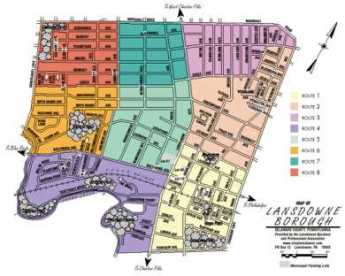
|
| Lansdowne Map |
The Granville, or Lansdowne, the family had so many members important in English history, that the Lansdowne name adorns countless schools, boroughs, colleges, museums and other monuments around the former British empire. It would require undue effort to sort out just why each memorial is named after just which member of the family. In the Philadelphia region, Lansdowne is the name of a small borough in Delaware County,
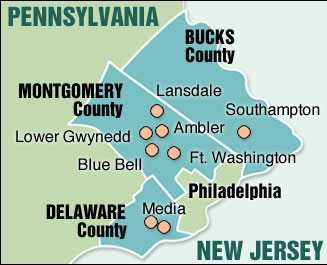
|
| Lansdale |
often annoyingly confused with Lansdale, a small borough in Montgomery County. However, it really seems more appropriate to focus reverence on the Lansdowne mansion, which from 1773 to 1795 was the home in now Fairmount Park of the last colonial Governor. That would have been John Penn, who was one of several Penns who still shared the Proprietorship until 1789, and who shared in the miserly payment which the Legislature of the new Commonwealth made as compensation for expropriating twenty-five million acres of their property. The French Revolution was going on at that time, so there were probably some patriots who would scoff that John Penn was lucky not to be guillotined.
The Penn family could see the Revolution coming, and like everyone else was uncertain who would win. Real decision-making for the Proprietorship rested with Thomas Penn in London, a close friend of the King and his ministers. The strategy employed in this difficult situation was to surrender the right to govern the colony conferred by its original charter and to become mere real estate owners with John their local representative pledging local allegiance. That might have worked for a while, until General Howe's troops captured Philadelphia. Soldiers were dispatched to Lansdowne to tell John Penn he was under detention, to reduce his potential utility to the occupying army.
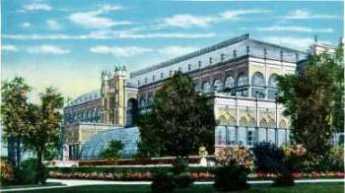
|
| Horticultural Hall |
As matters eventually worked out, some of the Penn descendants remained fairly wealthy after the Revolution, especially those whose wives had inherited substantial assets from other sources. But some were severely impoverished. The stately Georgian mansion burned down in 1854, and the site was then occupied by the Horticultural Hall of the 1876 Centennial Exposition. Perhaps because of misplaced patriotic fervor, it is now difficult to find a picture of Lansdowne.
The elegance of the place, on 140 acres, is suggested by the fact that William Bingham the richest man in America at the time, apparently acquired it from James Greenleaf the partner of Robert Morris, and the nephew by marriage of John Penn, who acquired it from Penn's estate but probably had to give it up in the financial disasters of Morris and his firm. Lansdowne was still a grand manner when it was briefly acquired by Joseph Bonaparte, the former King of Spain. In view of the fact that Bingham had provided President Jefferson with the gold to finance the Louisiana Purchase from Napoleon Bonaparte, and earlier had practically forced the Congress to call off an impending war with France, there was likely a connection here.
And to some extent, the ill-treatment which John Penn received from the Pennsylvania legislature (roughly fifteen cents an acre) in the Divestment Act of 1779 can possibly be traced to the unrelenting hatred by Benjamin Franklin, Pennsylvania's icon. History does not tell us what made these two former friends fall out in 1754, sufficient to make Franklin willing to spend years in London trying to get the colony away from the Penns. The feeling was surely mutual. When John Penn was offered the patronship of the American Philosophical Society, he declined, just because Franklin was its president. In retrospect, that sounds unwise.
Rubberneck Tours of Philadelphia (1)
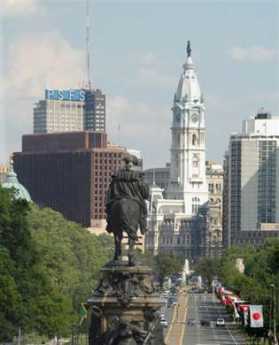
|
| Center City Philadelphia |
To qualify as a rubberneck tour, a route can be traveled in two hours by car, avoids the unsightly parts of town, strings together a lot of interesting sights which are of interest to visitors from out of town -- and educates the life-long residents as well. Several tours qualify, and it's a pity you can't go to someplace near City Hall and select one of them from a line of buses. Perhaps in time tourism will reach the point where this is possible.
For a start, go West from the center of town, out Walnut Street to 33rd Street, turn right. You won't see all of the University of Pennsylvania, but you will see a lot of it, followed by the campus of Drexel University. This was once a very elegant district, and many Victorian mansions can be seen as you go out to the Zoo. Navigate around a little with a map and get on Belmont Avenue. Be sure to get a glimpse of Sweet Briar mansion, peeping through on the right. You will be able to see Memorial Hall and other remnants of the 1876 Exhibition, soon to be the site of the Please Touch Museum. Keep going on Belmont, past the Ohio House which dates from the Exhibition, and on out Belmont Avenue to City Line Avenue. Here's the surprise.
Cross over City Line Avenue into Montgomery County and keep going. You will go past some lovely houses on the left, and the borders of Laurel Hill Cemetery on the right. You are going downhill now, through the woods, and you sweep around the right to the bridge over the Schuylkill. Didn't expect to go out of the city into the woods so abruptly, did you?
And now, crossing the Schuylkill, turn abruptly right on to Main Street in Manayunk. Another scenic shock, as you emerge from a country lane onto several miles of a gentrified abandoned factory town. In the summer, there are an awful lot of people sitting at sidewalk tables, talking about who knows what. Perhaps they are mostly resting their feet from shopping, whatever that means, in all the little stores now selling shoes and kerchiefs, apartment furniture, and knick-knacks. After a while, Main Street turns into Ridge Avenue, which eventually leads you back to the Benjamin Franklin Parkway, and back to City Hall. A somewhat prettier drive is closer to the river, with the landscaping and boathouses of the Schuylkill Navy.

|
| Fairmount Park |
But continuing on Ridge Avenue allows you the option of an abrupt turn left on Schoolhouse Lane, where it's admittedly a little hard to find and navigate a left turn, scooting you abruptly back up a steep hill and into the woods again. Turn right on Vaux, right again on Warden Drive, and then left to Midvale, following it down to rejoin Ridge Avenue at the bottom of the hill. This little side-trip allows you to see some pretty unexpected woody suburbs, and if you have been told where to look, the former home of Grace Kelly, and the homes of Senator Spector and Governor Rendell.
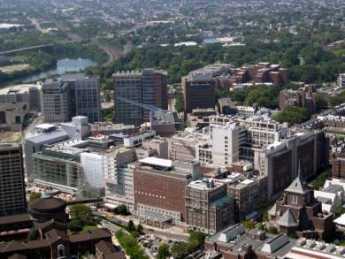
|
| UPENN |
Give it a few years, and Ridge Avenue at this point is sure to get gentrified like Main Street, back up that hill in Manayunk. Now, either take Kelly Drive back into town, or continue down Ridge past old (East) Laurel Hill Cemetery and a brief spin into Sedgely and the mansions along the cliff in East Fairmount Park. Or a brief detour over the Girard Street bridge to the edge of West Fairmount Park is worth a few minutes, returning by the Spring Garden Street bridge to the back of the Art Museum, and then down the Parkway.
You've just had a pleasant two-hour tour, researched and designed by the history department of the University of Pennsylvania to illustrate Philadelphia's role in the days of the Civil War. Back then, the area roughly enclosed by our rubberneck tour #1 was just beyond the edge of the town, an ideal spot for many training camps for the Union Army. Further south on the Schuylkill at that time was a collection of factories known as the "arsenal of the North". This more northerly part of town, now filled with thousands of brick row houses, was once let us say, the boot camp of the North.
Sugarloaf

|
| Germantown Map |
Germantown Avenue goes continuously uphill from its start at the Philadelphia waterfront until it reaches Sugarloaf in Chestnut Hill. It follows an old Indian Trail, and that's where the Indians apparently wanted to go. From Sugarloaf northward, it's all downhill.
The name derives from the shape of the hill at that point and is a fanciful description of the sudden shift from Wissahickon gorge to the Whitemarsh Valley, which occurs at that point. The underlying rock changes from hard "gneiss" to limestone. In early times, this was the location of the farm of William D.Stroud, whose son was Teddy Roosevelt's doctor and the first one to introduce the electrocardiogram to this country. Around 1928, James Page built an imposing mansion with a wrap-around porch at the top of the 40-acre estate, naming it Wycliffe. Around twenty years later, the real estate magnate Albert M. Greenfield acquired the property, which eventually was given to Temple University as a conference center, although a fire destroyed the wrap-around building. That's Sugarloaf, and you can visit it.
Two stories about Greenfield, himself, still circulate around town. The first concerns a banker who met Greenfield at the corner of 15th and Walnut Streets.
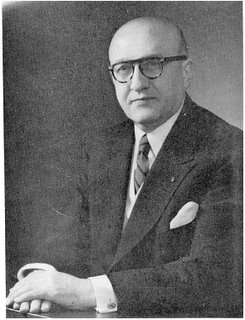
|
| Albert Greenfield |
The real estate man was looking up at the massive old Drexel building, where Anthony Drexel and J.P.Morgan were partners, and where Edward T. Stotesbury made lots of waves during the 1920s. Stotesbury acquired a personal wealth of about $100 million as "the richest Morgan partner" and was determined to spend every penny of it before he died in 1938. The stories of the extravagance of this birthright Quaker, and particularly his wife, are legendary. Anyway, Stotesbury held court at a big desk, just inside the door at 15th and Walnut. Greenfield was standing outside that door, chatting with his banker friend.
"Do you remember that big desk where Stotesbury used to sit?" Yes. "Well, I used to sell newspapers at the corner here and watched Stotesbury go in and out. I want you to know I just bought that building, myself, and I'm going to put my desk right where Stotesbury used to sit."
Unfortunately, he never did. Within two months, he was dead of pancreatic cancer.
The other story was told of Greenfield's integrity, the sort of thing that was central to the long-standing success of Philadelphia businessmen in commerce and banking. When bargains are stuck in a conversation, the deal is sealed with a handshake, and you better be as good as your word.
Hubert Horan, the Chairman of the Broad Street Trust, was interested in a piece of property, and over lunch agreed to pay Greenfield three million dollars for it. Before any papers were signed, another man came rushing into Greenfield's office and excitedly announced he wanted to buy the property. "I'm sorry," said Greenfield, "I just sold it to Hubert Horan". How much? "He agreed to pay three million for it." Did you sign anything? "No." Fine, I'm willing to pay you FOUR million for it."
"Well," said Greenfield, "I suggest you go see Hubert Horan. He owns it."
West Fairmount Park
Fairmount Park is considerably larger on the west bank of the Schuylkill than on the east, and the points of interest are somewhat more diluted by woods and pasture. Partly, that is a consequence of being the site of the 1876 Centennial Exhibition , and partly that urban growth had not encroached so much into the farmland at the time the park was created. On the west bank at the time of the Revolution, there were still 300-400 acre farms, whereas the east bank farms had been cut up into gentleman's
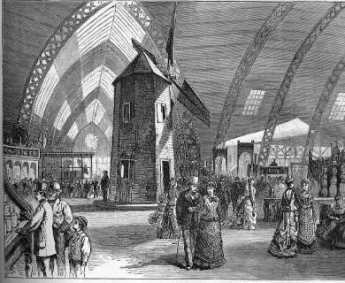
|
| Centennial Exhibition |
estates. The Schuylkill takes two 90-degree turns within the Park limits, leaving a point of high land on either side of the river. On the east side, the East Park reservoir is at the apex, and on the west side, the dominant point is Belmont Mansion. For a while, there was a restaurant at Belmont, but at the moment it's a pity but little advantage is taken of a very scenic view. Two judges once lived in the mansion, William Peters, and his nephew Richard Peters. William was a Tory and had to flee to England. Richard made a better guess and as a rebel, therefore could live on in scenic splendor.
For orientation, the West Park mansions extend in an arc from The Solitude in the south to Chamonix in the north. For the moment limiting our list to houses present when the Park was created, there is Sweetbrier, The Pig-Eye Cottage, Belmont, Ridgeland, Greenland, and the Lilacs. The last three houses belonged to three well-known Philadelphia families, Garrett, J.B. Lippincott, and Walnut, who established themselves in 19th Century commerce rather than 18th Century politics. Sweetbrier was one of those centers of French Philadelphia, when Samuel Breck continued his father's close relationship developed as the fiscal representative of French Forces in America, entertaining LaFayette and other such friends of the new Republic. The Pig-eye cottage is used by the Park administration, and closely resembles the Caleb Pusey house, but otherwise has no remarkable history. Solitude, on the other hand, really was the retreat for John, then Richard, then Granville. John Penn entertained George Washington here while he was presiding over the Constitutional Convention.
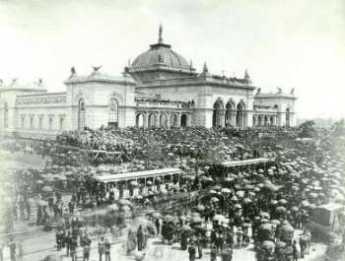
|
| fair |
Fairmount Park is notable for some buildings which are unfortunately no longer there, and some other buildings that were transplanted there. The East Park is a historical monument, while the West Park is more a house museum. Governor Mifflin's house is gone from the Falls area, Powelton is gone, and Lansdowne the estate where the Proprietor John Penn was seized by rebel soldiers. His family was later paid less than a penny an acre for the 21 million acres of Pennsylvania land they clearly owned. Sedgley is also gone, and all of these places have a place in history. On the other hand, it is well to remember that all of the industrial slums along the river were cleared away to be replaced by the charm of Boat House Row.
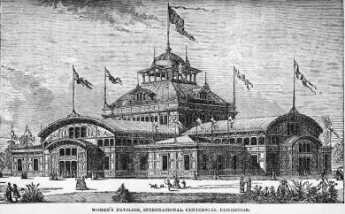
|
| Exhibition |
It keeps being repeated that Fairmount Park is the largest urban park in America, but the fact is it is bigger than the city can afford to maintain, just as a monument to the colonial style of life. It was a grand place to have a World's Fair in 1876, and Memorial Hall remains, along with the Japanese pavilion, a truly priceless reproduction of Japan under the Shogun. Fairmount Park has the first Zoo in America, still a place of note in zoological circles, and many ballparks, summer music halls, and other modern recreational attractions. It contains Cedar Grove, a splendid Quaker homestead in Welsh style, transported from its original location in Frankford. The Letitia Street House was too fine an example of 17th Century urban architecture to lose, so it was moved to the Park from Letitia Street, approximately 2nd and Market Streets. William Penn lived for a while on Letitia Street, named after his daughter, but it is not entirely clear who lived in this particular little house. There doesn't seem to be anything you can do about people calling it the William Penn House.
Fairmount Park is the largest urban park. It doesn't have roley coasters, but we don't miss them, and it doesn't have Mickey Mouse, at least so far. There is absolutely nothing like it anywhere. Anyway even if there were, Philadelphians wouldn't notice.
Fair Mount
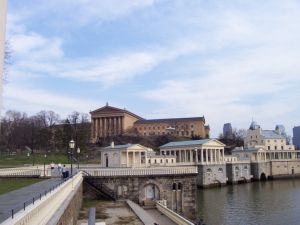 |
| THE FAIRE MOUNT |
Although the Art Museum now dominates the end of the Benjamin Franklin Parkway, the earlier focus of the acropolis once called Fair Mount is just down the hill behind it, in the old Grecian complex of the Philadelphia waterworks. When the Schuylkill was dammed at that point, the effect was to calm the rapids, drown the falls at Midvale Avenue upstream, and turn this portion of the river into a placid fresh-water lake. Fairmont Park was then created upstream in an effort (originally stimulated by the College of Physicians of Philadelphia) to reduce pollution of Philadelphia's water supply going into the pumps at the Waterworks, by replacing, with parkland, the wards, and industrial slums at the terminus of the canal bringing anthracite from upstate. The result was the creation of an ideal place for public boating and skating.
The transformation of this area can be seen in retrospect as an impressive civic response to economic upheaval. The War of 1812 (by cutting off ocean access to bituminous via the Chesapeake) had first forced Philadelphia to use anthracite hard coal, and the discovery of anthracite's superiority in making steel caused a continuing reliance on it and the canals
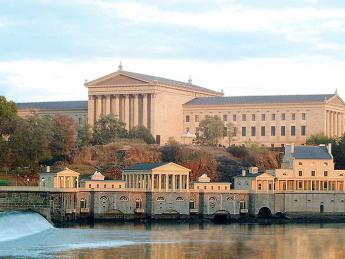
|
| Philadelphia's Water Works |
that brought it here. By 1850, the Philadelphia and Reading Railroad made the canals obsolete and created this splendid opportunity for urban renewal. The waterfalls had created a natural boundary between industry oriented to upstate coal and other industry oriented to oil and commerce coming up Delaware. It is a great pity that the lower section of the Schuylkill, once so famously beautiful, has never stimulated the same vision and imagination in response to the eventual decline of the industrialization which defaced it.
To return to Boathouse Row, a large azalea garden starts the Park, and then the East River Driver winds along the attractively landscaped riverbank. Just beyond the azalea garden, the first of ten Victorian-style boathouses starts the home of the Schuylkill Navy, an association of rowing clubs which are now a century and a half in residence there. When the Schuylkill auto expressway was created on the other side of the river, someone had the bright idea of decorating the rowing houses with lights along their edges in the manner used for Christmas decorations in South Philadelphia, especially on Smedley and Colorado Streets. Ever since the entrance to Philadelphia from the West has become one of its most arresting beauties.
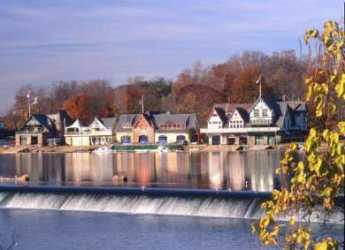 |
| BOATHOUSE ROW |
Add a few cherry blossom trees in the spring, and you have quite a memorable centerpiece. Rowing sometimes called crewing, or sculling, is a central focus of Philadelphia society, and is curiously not something in which the city can claim to be first or the oldest. As you might expect, "regatta" is a word invented in Venice five hundred years ago, there are records of rowing races as far back as 400 BC, and New York -- ye Gods! -- had the first American boating club. The Philadelphia Schuylkill Navy was formed as an association of rowing clubs in 1858, and the oldest member, the Bachelor's Barge, was only formed in 1856. The development was largely spontaneous and is said to have been briskly stimulated by a beer garden nearby, run by a former Philadelphia sheriff. About the same time, the British became crazy about the sport, having the Henley Races as the most famous regatta in the world, and both the Australians and the Bostonians occasionally have the largest, most expensive, most widely advertised regattas. Foo. Philadelphia has the Schuylkill Navy, and it is central to our existence.
There are a couple of things which are unique about rowing. In the first place, it is hard to think of a way to cheat. You can hire engineers to redesign the shape and size of your boat, but engineering really doesn't make a lot of difference once the basic development of oarlocks and movable seats was perfected. A good boat can cost as much as $30,000, but that is large because all boats approach the limit of speed. If you have heavier or stronger oarsmen, it doesn't make that much difference. What matters is coordination, and in the longer boats, teamwork. Pull up with your shoulders, push with your legs, don't start with your buttocks, the art of rowing involves your whole body. The greatest champion of all time, Edward "Ned" Hanlan,
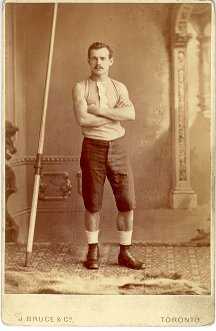 |
| EDWARD HANLAN |
only weighed 155 pounds. Not only was he world champion from 1876 to 1884, he was undefeated in any race during the last four years. True, he was born in Toronto, and eventually he was thrown out of polite Philadelphia racing for deliberately ramming another boat, but those are private Philadelphia comments, not something you want to talk too much about. The whole secret of rowing is to manage the fact that the boat travels farther between strokes than while the oars are in the water; if you row too fast, you actually slow the boat. There are two other Philadelphia names associated with the Schuylkill Navy. One is Thomas Eakins, the great American painter, one of whose most famous pictures is that of Max Schmitt in a Single Scull (on the Schuylkill). The other name is Kelly.
John B. Kelly of Philadelphia won two Olympic gold medals in 1920 and did it within one hour. He won a Third Olympic gold medal in 1924. But when he tried to race in the Henley Regatta, he was declared ineligible to row, because he had worked with his hands (summer work as a bricklayer), and thus could not really be called a gentleman. Anyone who has ever heard Irishmen talk about Englishmen can imagine the reaction this caused in the Kelly family. The resentment took the form of pushing his son, Jack, into racing, and in 1947 John B. Kelly, Jr. won the Diamond Sculls at Henley. Meanwhile, the father vindicated himself in other ways. The firm of Kelly for Brickwork was an enormous financial success, right up there next to Matthew H. McCloskey and John McShain, the political builders of the Pentagon and numerous other government buildings. John B. Kelly unsuccessfully ran for Mayor of Philadelphia in 1935 during the 75-year period when Philadelphia Mayors were always Republicans, but for decades was in the much more powerful position of head of the local Democratic party. The Republicans at that time would meet for lunch at the Union League, and so John Kelly reserved a lunch table at the Bellevue Hotel, next door, where he could be seen holding court every day.
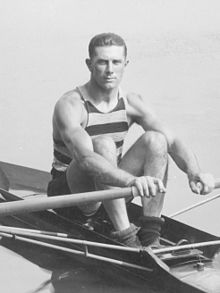
|
| John B Kelly |
The result was not entirely favorable for the Bellevue; more than one wedding reception was rescheduled to some other hotel in order to avoid the Democrat taint. But you always knew where you could find Kelly at lunch, and it was fun to watch the various minions come forward to the table, almost as if they were in chains, to pay homage which involved provoking loud laughter from the great man with a salacious joke. The rowing clubs are mostly big barns with old boats high up on the walls, and silver cups and wooden memorial plaques lower down. They have lockers and showers, but no dining rooms, except at catered in the evening for parties. For a century, no women came there, but now almost half of the rowers are female. Membership is not difficult to obtain, although you have to be good to get on the club teams, and the dues are not expensive. If you show promise, you are expected to spend most of your waking hours working at it. Jack Kelly was famous for rowing three hours every morning, going to lunch, and then coming back for a couple of hours of more rowing. That doesn't leave much time in your life for anything else, so the friendships developed among active club members are very strong, just like the horsemen over at the City Troop. They sort of life in the past a little, with many anecdotes about a skull that broke apart and sank in the midst of a race, or a race that was lost because of too much recreation the night before. The lingo has to do with the fine points. A race can be between "eights" or "fours", or doubles, or singles. It can have a coxswain, or not, and be coxed or unboxed. When a pair of rowers have two oars apiece, it is the normal arrangement. A much more difficult boat to control has two rowers, with one oar apiece. Like Hercules or Achilles, stories are told of Hanlan, great Hanlan, who sometimes would win a one-mile race by eleven lengths. Or who would get so far ahead of his competitors that he would lie down in the boat and wait for another boat to catch up -- and then race ahead to beat him. This sort of person can be a little hard to take, and it is privately muttered that Hanlan was sent off to Australia, where people do that sort of thing more commonly.
The Schools of School House Lane

|
| Union School founded in 1759 |
The region of Philadelphia defined as Germantown is recorded by the last census as having about 50,000 inhabitants today, 40,000 of whom are of the black race. Germantown has always had an unusual concentration of schools of the highest quality, and here on one street alone there are four. School House Lane runs off to the West of Germantown Avenue, and was originally right at the center of town, the center of the action during the Revolutionary War. The most historic of the schools, the Union School founded in 1759, changed its name to Germantown Academy, and more recently picked up and moved to new quarters in Fort Washington. George Washington sent his nephew there, and its building served as a hospital for the wounded in the Battle of Germantown. When Germantown Academy moved out of Germantown, the Pennsylvania School for the Deaf moved into the vacated quarters. This school had been originally founded in 1820, and is one of nearly a hundred special schools for the deaf in the United States, operating as a quasi-public institution for about 170 students. A remarkable thing about all schools for the deaf is the high IQ of their students. Perhaps deaf underachievers are somehow filtered out by the struggle to adapt before they apply for admission, or perhaps there is something about being deaf that makes you smart. In any event, the average SAT scores of students from PSD, like all schools for the deaf, are always in the very highest ranks among secondary schools.
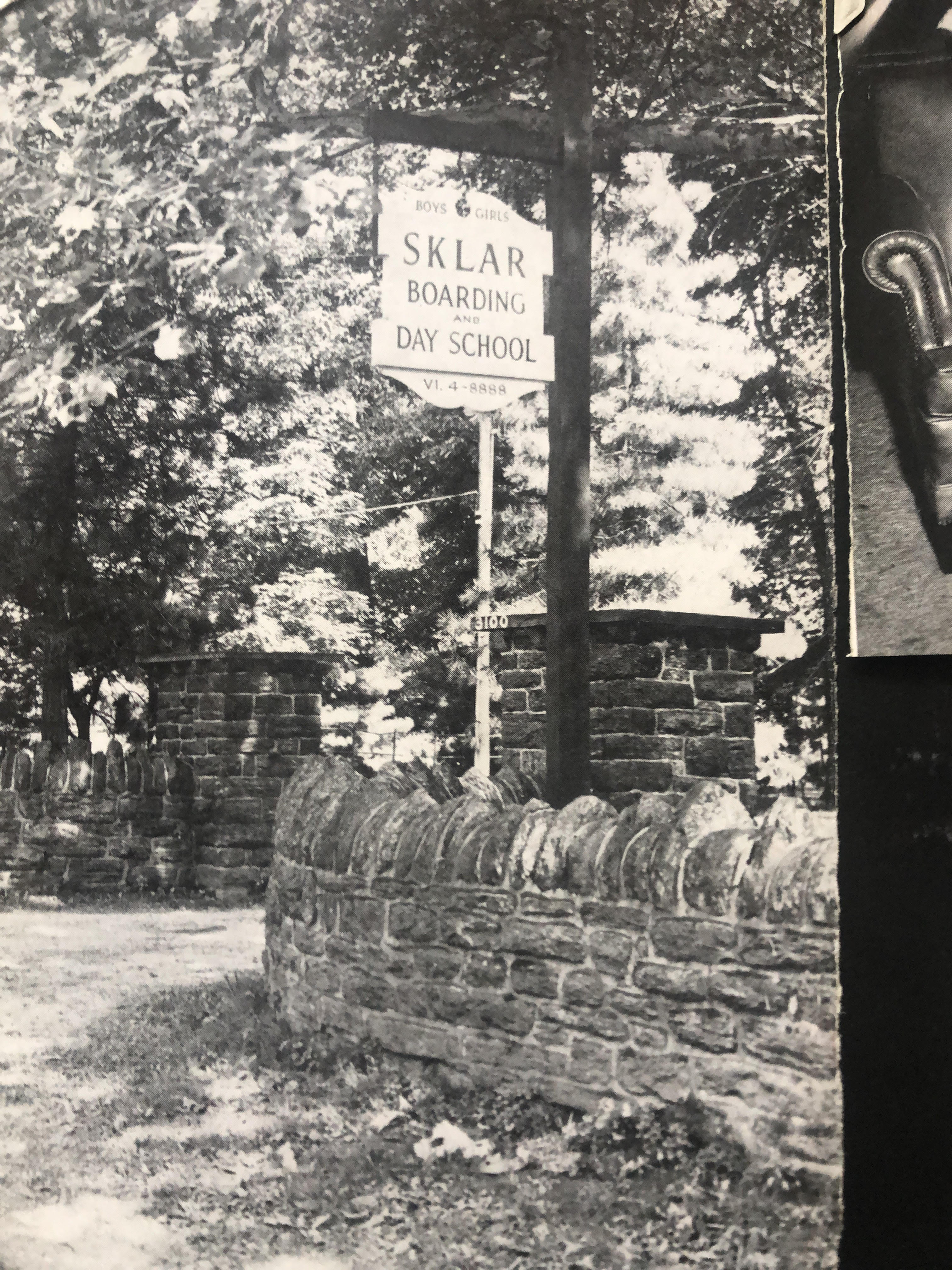
|
| Sklar School Entrance |
More or less next door to it, fronting on Coulter Street, is the Germantown Friends School(GFS), which enjoys and deserves the reputation of the most intellectually rigorous school in the Philadelphia region. There is little question about the Quakers of this school, founded in 1845, but relatively few of the students are now Quaker children. It's pretty expensive and quite uncompromising about its academic standards, but if you want to be accepted by a famous University, this is the place that can boast the most achievement of that variety. By no means all of its graduates become teachers, but alumni of this school do tend to gravitate to the top of academia. That could eventually put them on college admission committees, of course, and perhaps the admission process promotes itself. There can be little doubt that if most of a given college's admission committee happened to play the tuba, that university would soon fill up with tuba players.
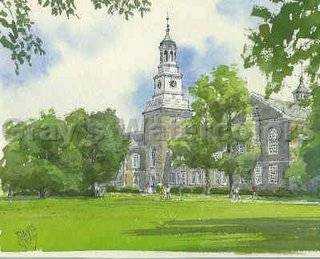
|
| William Penn Charter School |
Further West on School House Lane, is the William Penn Charter School. It's also Quaker, and while it doesn't work quite so hard at it as GFS does, it has plenty of social mission, a great deal more discipline, and plenty of competitive athletics. A minority of its students, also, are Quakers; but as a guess, most of its graduates are headed for disproportionate affluence anyway. The middle school is named for, and was donated by, the former chairman of Morgan Stanley back before Morgan Stanley sold itself to Dean Witter. This school was founded in 1689, and for a long time was located at 12th and Market Streets in Philadelphia, right where the famous PSFS building was built, the one that later converted to Lowe's Hotel .
Finally, near the crossing of Henry Avenue with Schoolhouse Lane, is the Philadelphia University. Since it was founded in 1999 it is the youngest of the schools on School House Lane, specializing in architecture and design, and seems headed for even broader curriculum. The University was formed by the merger of Ravenhill Academy for Girls, and the Philadelphia Textile School. The Textile School was itself formed during the 1876 Philadelphia Centennial, when local industrialists became concerned with how backward America seemed in its quality and design of textiles, compared with other nations which exhibited at that World's Fair. Next door, was once the home of William Weightman, a chemical manufacturer who was reputed to be the richest man in Pennsylvania. After his death, the rather grand estate became the site of the Ravenhill School for Girls, which was the school which could boast Grace Kelly for an alumna. That was natural enough since she lived just around the corner on Henry Avenue and could walk to school. The contrast between the two ends of School House Lane, Henry Avenue on one end, and Germantown Avenue on the other, is just astounding.
So there you have School House Lane. A few short blocks with three distinguished preparatory schools and a university. Plus, the site of three other famous schools which have either moved or merged. You might think Germantown was the home of myriads of school teachers, but that isn't exactly so. It's hard to say just what this complex anomalous situation proves, except to voice the opinion that it is somehow at the heart of what Philadelphia really is.
Note, kind readers have also sent me the names of six more schools on Schoolhouse Lane. Some of them may only be name changes, but the list includes Parkway Day School, Sklar School, Philadelphia Textile and Science, Germantown Stevens Academy, Germantown Lutheran Academy, Greene Street Friends School. (See Comments.)
The Quaker Who Would Be King
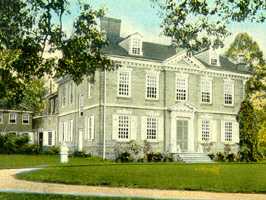
|
| Cliveden |
Two decades passed. What we now call the American Revolution started rumbling in far-off Lexington and Concord, soon moved to New York and New Jersey. General William Howe, the illegitimate uncle of King George III, then decided to occupy the largest city in the colonies, tried to get his brother's Navy up Delaware but hesitated to persist in a naval attack on the chain barrier blocking the river. He considered but abandoned trying to outflank the New Jersey fort at Red Bank, the land-based artillery at Fort Muffling, and heaven knows what else along the twisting shaggy Delaware river. Giving up on that approach, Howe sent the navy down to Norfolk and back up the Chesapeake, landing the troops at the head of the Elk River. Washington was outflanked at the Battle of the Brandywine Creek trying to head him off, although he suffered far fewer casualties than the British. A rainstorm, presumably a fall hurricane, disrupted his planned counterattack near Paoli. So Howe invested Philadelphia, organizing his main defensive position in the center of Germantown. His headquarters were in Stenton and Morris House, General James Agnew was at Grumblethorpe The Center of British defense was at set up at Market Square where Germantown Avenue crosses Schoolhouse Lane. With Washington retreating to Valley Forge, that should take care of that. Raggedy rebels were unlikely to attack a prepared hilltop position with a river on either side, defended by a large number of British regulars.
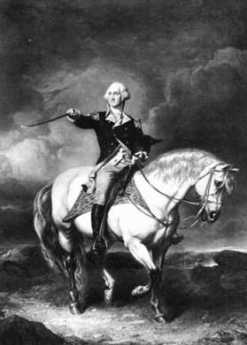
|
| George Washington |
Washington did not look at things that way, at all. Cut off from their fleet, the British situation would be precarious until Delaware could be re-opened. He had watched General Braddock conduct with bravado an arrogant suicide mission in the woods near Ft. Duquesne, and also knew the British always based as much strategy as possible on their navy. Washington's plan was to attack frontally down the Skippack Pike with the troops under his direct command, while Armstrong would come down Ridge Avenue and up from the side. General Greene would attack along Limekiln Road, while General Smallwood and Foreman would come down Old York Road. In the foggy morning of October 3, the main body of American troops reached Benjamin Chew's massive stone house, now occupied by determined British troops, and General Knox decided this was too strong a pocket to leave behind in his rear. Precious time was lost with an artillery bombardment, and unfortunately, the flanking troops down the lateral roads were late or did not arrive at all. The forward movement stopped, then the British counter-attacked. Washington was therefore forced to retreat, but he did so in good order. The battle was over, the British had won again.
But maybe not. Washington hadn't routed the British Army or forced them to leave Philadelphia. They did leave the following year, however, and there was meanwhile no great desertion from the Colonial cause. Washington's troops suffered terrible privation and discouragement at Valley Forge, but the crowned heads of Europe didn't know that. For reasons of their own, the French and German monarchs were pondering whether the American rebellion was worth supporting, or whether it would soon collapse in a round of public hangings. From their perspective, the Americans didn't have to win, in fact, it might be useful if they didn't. But if they were spirited and determined, led by a man who was courageous and resolute, their damage to the British interests might be worth what it would cost to support them. The Battle of Germantown can thus be reasonably argued to have been an advancement of colonial goals, even if it could not be called a victory. However, when the news of Burgoyne's defeat at Saratoga soon reached them, the European enemies of England decided the colonists would be useful allies.
In Germantown itself, the process of turning a military defeat into a strategic victory soon began, with severe alienation of the German inhabitants against the destructive experiences of British military occupation. After a winter of near starvation, Germantown would never again see itself as the capital city of a large German hinterland. It was on its way to becoming part of the city of Philadelphia.
Community Volunteers in Medicine
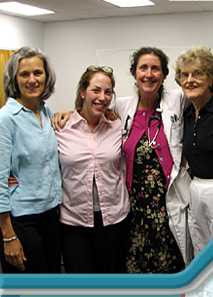
|
| Comm Volu In Medicine |
Mary Wirshup has a very different medical background from mine, but she's my kind of doctor. I couldn't help wishing, as she addressed our urban luncheon club, there could be thousands more like her, even while understanding more fully than she seems to, the reasons why doctors are driven from her behavior model. As we parted, it felt like saying a last goodbye to the Spartans marching to Thermopylae.
As 46,000 medically uninsured persons in Chester County get sickness and injuries, they know that a Federal Law prohibits a hospital accident room from refusing to see them, so ways are found to shunt patients to the CVIM free clinic, run by volunteers. This law is, in turn, a response to a government-created situation where a hospital which "accepts" patients must keep them. Any economics teacher can tell you that supply/demand issues are best addressed by price adjustment, so price controls in whatever guise lead to shortages. I must say I have little sympathy with the devious strategies which hospitals often employ to disguise their rejection of uninsured patients. At the same time, I know a lifeboat will sink if too many climbs aboard. Nevertheless, the semantic switch from lack of insurance to lack of care implies that only more insurance can surmount the barriers to care, which is absurd. For one thing, I know too many hospital administrators who are paid a million dollars a year, and one who is paid two million. And at least two health insurance executives are in the newspapers with a net worth over a billion -- yes, that's billion with a b. We have reached a point where reducing all physician income to zero would only reduce "healthcare" costs by 10%. As I look at Dr. Wirshup's modest clothing I can only surmise she plans to continue her modest living until she is 80 years old, after which her savings might see her out. Squeezing physician reimbursement is not intended to save significant money, nor intended to restore physician incomes to more equitable levels. It is intended to address the oversupply of physicians without confronting either the universities or the foreign trained lobby.
The elite tranche of medical schools do their part to relieve physician oversupply without reducing class size, through the encouragement of their students to go into research. I was well along at the National Institutes of Health before I finally decided I had not gone into medical school with that goal, and returned to teaching and patient care in a more satisfying model not too different from CVIM's obviously Pennsylvania Dutch spirit. The Amish at the far western end of Chester County reject the whole idea of insurance; their most characteristic statement is "Don't send me no bills." That attitude is rather a contrast with the shiny housing and automobiles in the Silicon Valley developments of Southern Chester County, or even with some rather bewildered Quaker farm families scattered over the rest of the county next to the horsey set. Chester County is America.
On Second Street in Society Hill, next to the park where William Penn's house stood and a few feet from Bookbinders, is the house of Dr. Thomas Bond. Bond conceived the idea of building the first hospital in America and with Franklin's publicity machine succeeded in getting it built, to care for the "sick poor". Dr. Bond started a second enduring tradition as well. When the Legislature expressed doubt that the institution was sustainable, he pledged to convince the local medical profession to serve the poor without charge. Some of the legislators who voted for the measure did so in the belief that charity care would never appear so the gesture would be without cost. The physicians did indeed come forward, in sufficient numbers to run many institutions for two hundred years. In 1965 health insurance made its national appearance and has regarded the benchmark low costs of charity care as a threat, ever since.
Fernery
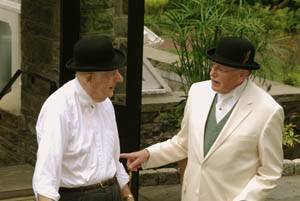
|
| Gardeners |
As explained by the curator of The Morris Arboretum, there are a few other ferneries in the world, but the Morris has the only Victorian fernery still in existence in North America. That doesn't count a few shops that sell ferns and call themselves ferneries; we're talking about the rich man's expensive hobby of collecting rare examples of the fern family in an elaborate structure. That's called a Victorian fernery. The one we have in our neighborhood is really pretty interesting; worth a trip to Chestnut Hill to see it.
Although our fernery was first built by the siblings John and Lydia Morris, it was rebuilt at truly substantial cost by the philanthropist Dorrance Hamilton. It is partly above ground as a sort of greenhouse, and partly below ground, with goldfish and bridges over its pond. Maintaining an even temperature is accomplished by a complicated arrangement of heating pipes. The temperature the gardener chooses affects both the heating bill and the species of fern that will thrive there. You could go for 90 degrees, but practical considerations led to the choice of 58 degrees. The prevailing humidity will affect whether the fern reproduction is sexual or asexual, a source of great excitement in 1840, but survivors of Haight-Asbury are often more complacent on the humidity point.
There are little ferns, big ferns, tree ferns, green ferns, and not-so-green ferns; the known extent of ferns runs to around five hundred species. Not all of them can be found in Chestnut Hill, what with humidity and all, but there are enough to make a very attractive and interesting display. For botanists, this is a must-see exhibit. For the rest of us, it's probably the only one of its kind we will ever see, a jewel in Philadelphia's crown, and shame on you if you pass it by.
Morris Arboretum
 The former estate of John and Lydia Morris is run as a public arboretum, one of the finest in North America. 
|
Morris is the commonest Philadelphia name in the Social Register, derived largely from two unrelated Colonial families. In addition to their city mansions, both families had country estates. The country estate once belonging to the Revolutionary banker Robert Morris was Lemon Hill, just next to the Art Museum, where Fairmount Park begins. But way up at the far end of the Park, beyond Chestnut Hill, was Compton, the summer house of John and his sister Lydia Morris. This Morris family had made a fortune in iron and steel manufacture and were firmly Quaker. Both John Morris and his sister were interested in botany and had evidently decided to leave Compton to the Philadelphia Museum of Art as a public arboretum. John died first, leaving final decisions to Lydia. As the story is now related, Lydia had a heated discussion with Fiske Kimball, at the end of which the Art Museum deal was off. She turned to her neighbor Thomas Sovereign Gates for advice, and the arboretum is now spoken of as the Morris Arboretum of the University of Pennsylvania. It is also the official arboretum of the State of Pennsylvania. To be precise, the Morris Arboretum is a free-standing trust administered by the University, with the effect that five trustees provide legal assurance that the property will be managed in a way the Morrises would have wished. In Quaker parlance, Lydia possessed "steely meekness."
A public arboretum is sort of an outdoor museum of trees, bushes, and flowers, with an indirect consequence that many museum visitors take home ideas for their own gardens. Local commercial nurseries tend to learn here what is popular and what grows well in the region, so there emerges an informal collective vision of what is fashionable, scalable, and growable, with the many gardeners in the region interacting in a huge botanical conversation. The Morris Arboretum and two or three others like it go a step further. There are two regions of the world, Anatolia and China-Korea-Japan, with much the same latitude and climate as the East Coast of America. Expeditions have gone back and forth between these regions for a century, transporting novel and particularly hardy or disease-resistant specimens. An especially useful feature is that Japan and parts of Korea were never covered with glaciers, hence have many species found nowhere else in the temperate zone. Hybrids are developed among similar species found on different continents, and variants are found which particularly attract or repel the insects characteristic of each region. The Morris Arboretum is thus at the center of a worldwide mixture of horticulture and stylish outdoor fashion, affecting millions of home gardeners who may never have heard of the place.
Please Touch
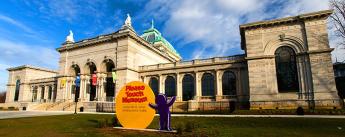
|
| Please Touch Museum |
There had been rumors for some time that the Please Touch Museum was planning to move from 21st Street to larger quarters, but recently its Executive Director Laura Foster appeared at a luncheon at the Franklin Inn Club to announce definite plans. The Museum moved into Memorial Hall in West Fairmount Park in the fall of 2008.
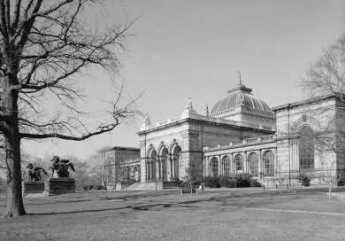
|
| Memorial Hall Fairmount Park |
There are over 400 children's museums in the world, and the first one was started in Brooklyn in 1899. Just why Philadelphia waited until the Bicentennial Celebration in 1976 to start one, is not clear. It's particularly unclear when you hear of its explosive success. Growing rapidly during an era when museums of all sorts are seeing declining attendance, the Please Touch Museum will be making its fourth move in thirty years, each time to larger quarters because they needed more room. Sooner or later, expansionism will get its comeuppance of course, and Memorial Hall is one awfully large building to fill. And to heat, and to paint, and to air condition. The price is right, however. The City Administration, which approached the museum with a proposal, has offered an 80-year lease for a dollar. When you hear that they have occasionally had 1500 visitors in a single day, however, and annual attendances approaching 200,000, almost anything seems possible.
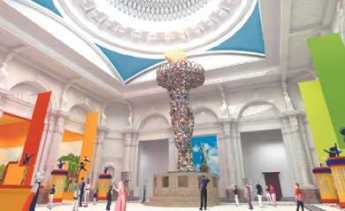
|
| Liberty Torch |
There are certain limits. Nothing frightens a 4-year-old like a herd of 10-year-old boys racketing about, so there are segregations necessary. In other situations, these little kids not only can't touch, but they also can't see and they want to see badly. And the sociology is interesting. The kids may well clamor to come when they hear other kids talking, but in general, it is the parents who get the idea that a museum trip would be fun. And the parents seem motivated by theories of upward mobility, of giving their child a "leg up" on the competition. The museum is certainly filling a need, but you have to wonder where our society is headed if a picnic in the park is mainly a good idea if it gives junior a leg up.
Meanwhile, keep tuned. To fill up that monstrous Memorial Hall will take publicity, and these gals sound as though they mean to have a lot of it.
Authors, Writers, Poets, Reporters and Publishers in Laurel Hill Cemetery
Boker, George Henry, (1824-1890), Section A, Lot 91. Poet and dramatist. Helped led its Civil War propaganda Activities.
Bradford, Andrew Section W, Lot 231 Andrew Bradford (1688-1742) published Philadelphia's first newspaper.
Brown, Charles Brockden, (January 17, 1771 - February 22, 1810), an American novelist, historian, and editor of the Early National period, is generally regarded by scholars as the most ambitious and accomplished US novelist before James Fenimore Cooper.
Bullitt, John Christian,(1824-1902)Section P, Lot 52. Lawyer and author of the Philadelphia City Charter.
Childs, George William.(1829-1894)Section K, Lot 337. Publisher of Victorian best sellers and one of Philadelphia great 19th century newspapers-the Public Ledger
Conrad, Robert, (1810-1858). Section 14, Lot 266. A literary figure who served as first Mayor of the Consolidated City of Philadelphia.
Cummings, Brig. Gen. Alexander (1810-1879) Section I, Lot 224 Founded the Evening Bulletin, oversaw procurement and raised troops in Civil War. Governor of the Colorado Territory. Nicknamed "Old Straw Hat."
Curtis, Louisa Knapp. (1852-1910)River Section, Lot 31. Editor of the Ladies Home Journal.
Duane, Mary Morris (Section L, Lot107-112) was a Poet.
Elverson, James. (1828-1911). Section T. Lot 41. Developed the Inquireras a major newpaper.
Fagan, Frances.(Fanny)(1834-1878) Section G, Lot 272, first daughter of John Francis Fagan by his first wife, Mary (Armstrong). Fagan committed suicide and was buried at Laurel Hill Cemetery, on 2 February 1878. Poet.
Godey, Louis Antoine. (1804-1878) Section WXYZ Oval. Lot 3. Publisher of America's first great magazine for women-Godey's Lode's Book.
Hale, Sarah Josepha. (1788-1879). Section X, Lot 61. Editor of Godey's Lady's Book, a crusader for women's medical education, and the person chiefly credited with establishing Thanksgiving as a national holiday.
Hildeburn, Mary Jane,(1821-1882) Section G-190. Author of Presbyterian Sunday School stories.
Hirst, Henry Beck.(1817-1874). Section Q, Lot 225. Poet
Hooper, Lucy Hamilton. Section W, Lot 17 was an assistant editor ofLippincott's Magazine from the first edition until 1874. She also wrote for Appleton's Journal and the Evening Bulletin. She wrote several books of poetry and she was also a playwright. One of her plays, Helen's Inheritance, had its premiere at the Madison Square Theater in NYC. After moving to Paris in 1874, she became the "Paris correspondent" for various American newspapers. She was also a novelist, with one of her novels, Under The Tricolor, causing quite a stir. It was a thinly-veiled satire of the lives of certain expatriates who were living in Paris at the time.
Kane, Elisha Kent. Section P, Lot 100. Elisha Kent Kane(1820-1857) became famous for his arctic explorations. Kane's publications include: "Experiments on Kristine with Remarks on its Applications to the Diagnosis of Pregnancy," "American Journal of Medical Sciences, n.s., 4 (1842), The U.S. Grinnell Expedition in Search of Sir John Franklin, A Personal Narrative, New York: Harper and Brothers, 1854, and Arctic Explorations in Years 1853, '54, '55, Philadelphia: Childs and Peterson, 1856.
Lea, Henry Charles.(1825-1909) Section S, Lot 49. Pro-Northern propagandist during the Civil War, Civic Reformer, and author of a classic history of the Spanish Inquisition. Sculpture by Alexander Stirling Calder.
Leslie, Eliza. (1787-1858) Section6, Lot 45. Author of MissLeslie's Directions for Cookery (1851)and other cookbooks.
Lippincott, Joshua B. (1831-1886)Section 9, Lot 118. Founder of the distinguished Philadelphia publishing company.
Marion, John Francis. (1922-1991) Section S, Lot 118. Philadelphia historian, author, and gentlemen.
Mc Michael, Morton.(1807-1879) Section H, Lot 45. Publisher of the North American, mayor of Philadelphia, and president of the Fairmount Park Commission.
Neal, Joseph Clay, (1807-1847) Section P, Lot 71. Editor and humorist, best known for Charcoal Sketches in a Metropolis.
Read, Thomas Buchanan. (1822-1872) Section K, Lot 206. Both poet and sculptor, Read is best remembered for his Civil War poem "Sheridan's Ride".
Singerly, William. (1832-1898) Section K, Lot 235. Made fortunes in street railways, real estate, knitting mills. Published the Philadelphia Record.
Townsend, George Alfred.(1841-1914) Section 9, Lot 98. One of the most important American Journalists during the Civil War and Reconstruction.
Wireman, Katharine Richardson. Section 9, Lot 160. was an illustrator who studied with Howard Pyle. She worked for the magazines that Curtis Publishing produced.
Wister, Owen. (1860-1938) Section J, Lot 206. Author of The Virginian. American writer whose stories helped to establish the cowboy as an archetypical, individualist hero. Wister and his predecessor James Fenimore Cooper (1789-1851) created the basic Western myths and themes, which were later popularized by such writers as Zane Grey and Max Brand.
Gettysburg
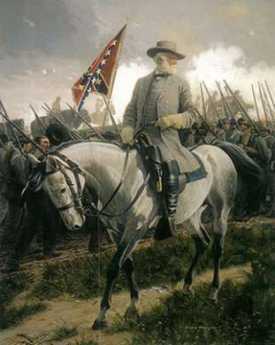
|
| General Robert E. Lee |
It's quite a long drive from Philadelphia to Gettysburg, but General Lee was attempting to disrupt supplies to the "Arsenal of the North" by capturing the railroad center at Harrisburg. Furthermore, Philadelphia reacted as if Lee's advance was aimed straight at us, creating hysterical preparations for an invasion which had to be stopped before it got here. And finally, George Gordon Meade, the Union commander, was a Philadelphia home town boy. So, regard the Battle of Gettysburg as part of Philadelphia history, please.
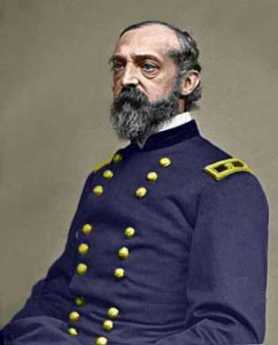
|
| General George Gordon Meade |
Major (ret.) Lawrence Swesey is a West Point graduate and currently Administrator of the 1st City Troop; because of his enthusiasm for the subject, he runs a tour agency which specializes in battlefields, especially Gettysburg. From him, the Right Angle Club recently learned much that made the whole episode comprehensible. Such as Lee's purpose in going there, which appears to have been based on the growing recognition that the South was likely to lose the war, and desperately needed some major victory in Northern territory, both to take the pressure off the Southern homeland and to improve whatever terms might be extracted at a peace negotiation. To fight successive battles against a larger enemy, with larger economic resources, was to doom the South eventually as resources and men were depleted with no hope of replacing them. Sooner or later, some Union General like Grant would settle down to a grinding unrelenting assault, with the willingness to trade one death for another, until only the larger side was left standing. That's quite different from guerilla warfare of the type Washington fought, where the way to win was simply to avoid losing until the stronger side lost its civilian support. Lee could feel the South beginning to lose its nerve to fight on indefinitely, without any visible route to victory. Although Grant eventually did defeat him by attrition, Grant's own opinion appears to have been more personalized. In every war, he was later to say, there comes a time when both sides want to quit. The side that wins is the one with a general who keeps fighting for no particular reason until the other side finally quits and he wins the war.
Major Swesey emphasizes that rifles were available, but they cost four times as much as smooth-bore muskets which were only effective for twenty or thirty yards. Rifles were reserved for sharpshooters, and the enemy at a distance was bombarded by artillery as the two sides approached. So, in Pickett's famous charge, most of the casualties took place in the last fifty yards. Pickett's men had to contend with trudging stoically through an exploding field of cannon fire, unable to fire effectively at the Union men behind a stone wall, who were also supposed to lie passively on the ground while the Confederate artillery pounded at a stationary target. Somehow, most of the Southern artillery fire went over the Union heads and landed beyond the crouching line; in many ways, this was the main factor in the Union victory.
As the waves of attackers got within musket shot of the wall, they formed into three ranks. Since it took about a minute to reload the musket, a more or less continuous fire could be maintained by rotating three successive volleys rank by rank, at more or less point blank range. Then, fix bayonets, and the real slaughter became a hand to hand, in the blazing heat of summer.
www.Philadelphia-Reflections.com/blog/1436.htm
The Man Behind the Mann
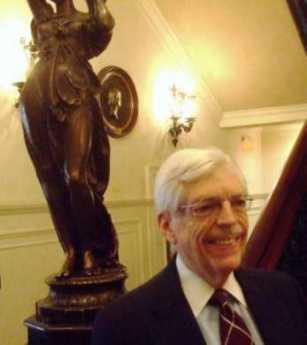
|
| William Leonard |
William Leonard, a distinguished lawyer retired from the distinguished firm of Schnader, Harrison Segal and Lewis addressed the Right Angle Club recently about his adventures running the new and improved Mann Center in Fairmount Park. A member of the board, he was suddenly asked to act as interim CEO when Peter Lane went on to another career. His task was to hold the organization together, while a permanent replacement was recruited. It turned out that directing an organization and actually running it are two entirely different things. It was necessary to learn about show business programming, the problems of rock groups, the whims of donors, the headaches associated with food vendors, and lease renewals with city governments, not to mention the rigidities of state and federal rules. Leonard obviously enjoyed the challenge, although most of us wouldn't.
The Philadelphia Orchestra had been playing summer concerts in the park since 1930, eventually adopting the name of Robin Hood Dell, East. Although the city contributed a couple hundred thousand dollars of support, and several hundred thousand other dollars came from non-ticket sales, classical music was always a long way from breaking even. The big revenue came from Rock Concerts, which may have been humiliating for the classical musicians of international fame, but was nevertheless what it took to survive, take it or leave it. Fred Mann in 1976 took the lead in raising funds for a roofed outdoor performance center, and the enormous energy of Peter Lane was brought from the New York Pops to get things going. In ten years, the Mann Center increased its outside support to $2.8 million of the $8 million annual budget and was putting on forty performances a season, with attendance increasing by 20% from 2006 to 2007. All this was accomplished in spite of the city government dropping its contribution to zero, and dropping music courses in the school system.
In a sense, the city stringencies may have been a blessing for the Mann. A second capital campaign raised $15 million for expanded facilities and parking, as well as an education center, to meet the new community need. A complimentary ticket program distributes 50,000 free tickets yearly, and seats on the lawn cost $10. If you want to get under the roof, it costs more. The free program familiarized parents with the program, and the educational center is now thriving.
Mr. Leonard brought along the new CEO, Cathy Cahill, and it looks as though he made a good choice. She's only been here for 19 days, but she went to Temple and Drexel before taking jobs out of town. She's a cellist herself, which should ease labor relations somewhat, although the pep and enthusiasm are surely innate. We hear that SEPTA is planning to re-open the R-5 station, and jitney bus service for the whole Park complex will be shared with the Please Touch Museum and other new activities in the 1876 exhibition area. There are plans for a Shakespeare repertory group to have a home here. This drive and enthusiasm are going to be necessary because Rock Groups are now competing in the Wachovia Center, and the Tweeter Center in Camden. Apparently, the secret of classical music finances leaked out.
www.Philadelphia-Reflections.com/blog/1479.htm
Chester County, Pennsylvania
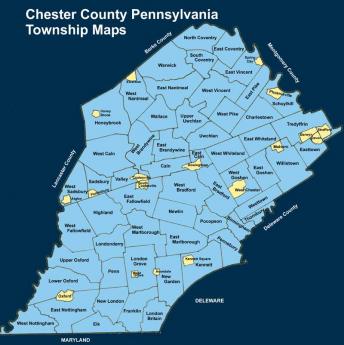
|
| Map of Chester County |
Chester County was one of the four original counties of Pennsylvania, as first laid out by its first white owner, William Penn. Although several parts of Chester County have been cut away, what's left is still quite large. Lancaster County was separated in 1729, and in 1785 Dauphin County was separated from that. In 1789, Delaware County was separated. If you stand in the horse country of Chester County, you still might find it hard to believe anything much has happened in three hundred years. But as a matter of fact, the present population residing within Penn's original boundaries of Chester County would make it the most populous county in the state and growing steadily. Since Philadelphia and Pittsburgh are meanwhile shrinking in population, projected future relationships would strike most residents of Chester County as quite remarkable. Horses, that's what Chester County wants to be all about. Even the mushroom growers of Kennett Square sort of count as part of the horse industry, because mushrooms are grown on horse manure, in the dark. Electronics and steel mills are not exactly traditional, but they reside here, too. As a small footnote, the Lukens Steel Company was recently purchased by an investor named Ross, who lumped it with several other steel mills and then sold the bundle to an owner in India. The consequence is that Chester has a footprint of the largest steel company in the world, or the largest steel company in India, whichever way you wish to style it. Nevertheless, the neighborhood still looks like horse country.
Furthermore, southern Chester County is socially part of the state of Delaware, while western Chester County is thoroughly Pennsylvania Dutch. Up north, the Philadelphia Main Line is building mansions as fast as mortgage originators will allow, and many of them end up paying Chester County taxes. All along Route 202, the central artery of the Great Valley, stretches a burgeoning electronics industry, within which is found Vanguard, the largest investment company in America, or possibly the second largest, depending on temporary quirks of mark-to-market pricing. Chester County presently has the highest average personal income of any county in America. It is far from true that everybody has a horse farm or a trust fund.
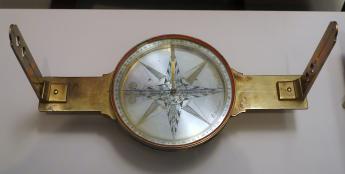
|
| David Rittenhouse's compass |
In a spiritual sense, Chester County horse culture contiguously spreads far beyond even historic outlines of Chester County. The boundaries of southeastern Pennsylvania were laid out with David Rittenhouse's compass, so the rolling hills suitable for horse farming extend into the states of Delaware and Maryland, and of course out into Lancaster and Dauphin counties, without much visible sign of individual state or county. In Europe, by contrast, almost all boundaries are set by rivers and mountain ranges, so the physical appearance of the countryside is apt to change sharply when crossing political borders. In fact, it is possible to say it in reverse: the State of Delaware is mostly Chester County extended, at least in its upper third. Below that lies urban and suburban Wilmington, and below that ("south of the canal") spreads loamy flat farm country, formerly slave country. Maryland divides similarly; an upper third of Maryland's rolling hillsides (sometimes known colloquially as Chester County extended), followed on the south by tidewater Maryland, in turn, followed by the suburbs of Washington, DC. The remnants of Baltimore are mixed in there somewhere, too. When you drive through miles of silent prosperous farms, regardless of highway signs, it is natural to think of yourself in the heart of America.
The one thing Chester County never much warmed to was Universities. It may shock residents of New York City to hear that Chester County never thought much of having its own art museums, classical music, theater performances or opera. However, Chester County doesn't share typical urban dislikes, either. Local speech patterns suggest Appalachian hillbillies and the Pennsylvania Dutch L'il Abners are just like us, just not so rich. Chester County sometimes thinks of itself as nobility, but it isn't Ivy League nobility, it's a country squire. We all like horses, dogs, and guns, we can't imagine why everyone else doesn't like them, too. Chester County has more history than almost anybody; it just doesn't talk much about it.
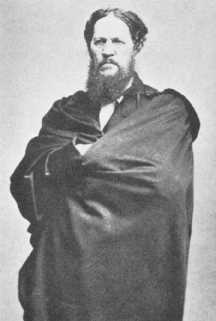
|
| Josiah Harlan |
So let's mention just the highlights: George Washington fought the battle of the Brandywine, the biggest battle of the American Revolution, in Chester County, the Paoli Massacre was long regarded as the second nastiest event of that campaign. A local farmer's son, Josiah Harlan (1799-1871), did what the Tsars and Dictators of Russia and the Kings and Queens of England couldn't do; he conquered Afghanistan. Moreover, he did it single-handedly, making himself King. Even the 350 American Rangers who conquered Afghanistan in 2002 can't match that exploit by this local Quaker boy. The first intern doctor of the first hospital in America (Jacob Ehrenzeller) spent his long life practicing in Chester County. The only President of the United States to come from Pennsylvania (James Buchanan) hailed from Lancaster, not terribly long after it split off from Chester County. In a wry sort of way, it can be said that Buchanan created the Republican Party by almost getting us to annex Cuba. Harrisburg, the present capital of the state, was once part of Chester County. Major portions of both British General Howe's and General Washington's armies left the Brandywine battlefield and swept up the Great Valley of Chester County to Philadelphia and Valley Forge, respectively. Conestoga Creek was once part of Chester County, and Conestoga wagons took many generations of settlers westward to build the new nation; wagons do go pretty naturally with horses. But drive through miles of Chester County today, usually alone through the silent stone barns and rolling grasslands: nothing much seems to have happened except real estate is more expensive.
But then, just drive up Route 202 from Wilmington to King of Prussia, at rush hour. This may be the Great Valley where Washington retreated to Valley Forge, but now it's where employees of the electronics industry ferry children to school, in order to get into the Ivy League, and maybe to shop at fancy stores in King of Prussia. With time out for a recession, it could be wall-to-wall McMansions around here in a generation. It seems almost certain the future will bear little resemblance to the past. It's sort of a pity, it is a great economic opportunity, and it seems inevitable.
Heavenly House
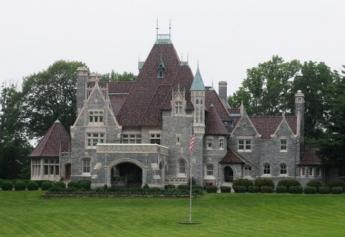
|
| Father Divine House |
While prosperous people, on deciding to enter a retirement community, are often heard to say they are tired of managing a big house, it can also be noticed that people who get the foreign travel bug usually drift around to see the palaces, castles, and estates of kings and emperors. The king's bathroom plumbing is a stop on most tours. Places like Buckingham Palace, the Vatican, the Temples of Karnak, Fortresses of Mogul Conquerors of India, or similar places in Cambodia, are all vast looming piles of stone dedicated to the memory of departed leaders who Had it All. That's probably all you need know, to understand that Americans who have it all tend to build huge show places, too. A great many do discover the castles to become just too much bother. Safe protection and privacy are somewhat separate issues, reasons given for putting up with a big place past the time the thrill has worn off. Perhaps such jaded feelings appear at the end of the wealth cycle. Nevertheless with enough affluence, if you had unlimited money and inclination, where around Philadelphia would you put a dream palace, one built for a modern Maharajah? Answer: close to Conshohocken.
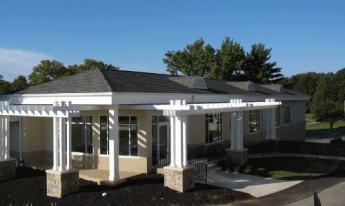
|
| The Philadelphia Country Club |
The Schuylkill takes a sharp bend at Conshohocken because it flows around a big cliff on the west side of the river. It was there the White Steel Company built the first wire suspension bridge in the world, as distinguished from cable (twisted wire) suspension bridges invented by Roebling at Trenton. The bridge was swept away by a flood, the steel mill replaced by the Alan J. Wood Steel Company. Alan Wood prospered mightily, and built his mansion ("Woodmont") on 75 acres on the top of the big rock on the west side of the Schuylkill, in such a way he could watch the smoke rising from his factory down below at the foot of the cliff. The Philadelphia Country Club is across the road from Alan Wood's mansion, with fairways clinging to the cliffs, a Gun Club for trap shooters who want to aim away from houses and toward mountainsides, and a cliff-top road leading straight for Gladwyne between dozens of mansions with five-acre lots. Down the hill, however, rocky projections force the road to funnel into a winding crooked road which ends up near the filling stations of Conshohocken, passing ancient farm structures on the way. Railroads and expressways tend to fill the valley, the old White bridge is gone, and two distinct cultures are within a few hundred oblivious yards of each other. To the west stretches the Main Line, now filled with houses almost as large as the mansion, but air-conditioned and filled with other modern amenities. Seventy acres of a lawn is nice, but it's a lot of grass to cut.
The Alan Wood Steel Company had a hard time in 1929, recovered somewhat after World War II, and then declined to the point where Lukens and Phoenix Steel took over. And then Indians from India took over the lot, forming part of the largest steel complex in the world, now headquartered abroad. In 1952, one of Father Divine's religious followers named John Devoute gave Father the Wood mansion; which then became the new headquarters of his religious sect. He died in 1965 but Mother Divine still lives there in stately and tasteful semi-seclusion. The grounds of the estate are beautifully tended by various of the twenty-five attendants of Mother. Father's mausoleum is near the house.
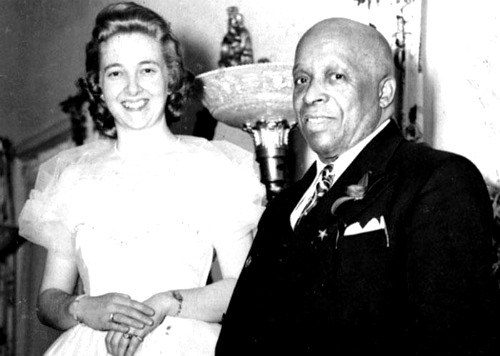
|
| Father and Mother Divine |
The house itself is patterned after Biltmore in Asheville, NC, although perhaps only a quarter as large. Just inside its portecachier, the oak-paneled living room has a ceiling 45 feet high, and many oriental rugs. There is a music room, off to the side of which is Father's former office, bearing a strong resemblance to the Oval Office in the White House in Washington. As planned, the living room window looks down the valley to the site of the old steel mills, although when the trees are leafed out it may be difficult to see. The dining table probably seats forty people, although the paneled dining room was fitted with electronics and used to broadcast sermons to religious adherents across the country. In the living room are testimonies to the many who seemed to rise from the dead, or who had their blinded sight restored, or who were crippled but enabled to walk. The attendants take visitors on tours, but Mother Divine likes to meet them, coming down the sweeping staircase without noticeably showing her age. The greeting of "Peace" replaces the usual "hello" and "goodbye".
At one time, the Religion housed a large number of single women in several hotels, and the invested proceeds of their work as domestics still supports the Religion. The religion frowned on gambling, drinking, smoking, and sex. However, celibacy inevitably leads to a decline of numbers, particularly evident since the death of the founder.
Museum of the American Revolution
The Right Angle Club of Philadelphia was recently pleased to be visited by Michael C. Quinn, the President, and CEO of the forthcoming Museum of the American Revolution, which will be built at Third and Chestnut Streets, on the site of the former Visitors Center. Mr. Quinn comes to us from the Mt. Vernon and James Madison Museums in Virginia and expects to spend another three years getting the new Museum built and established. It's also expected to cost about $150 million, so look for something really special. The great majority of the required money is expected to come from Philadelphia and surrounding territory, led by a challenge grant from Gerry Lendfest of $40 million.
The collection of Valley Forge and related Revolutionary artifacts was begun by Herbert Burk, an Episcopal rector in Norristown, Pennsylvania, and the son of another Episcopal rector of Clarksboro, New Jersey, and who graduated from the University of Pennsylvania toward the end of the Nineteenth century. The Valley Forge area was pretty well deserted at that time, and the local bishop expressed doubt that it could support both an Episcopal and a Baptist church, particularly since an earlier rector named Guthrie had attempted it and finally disappeared. Reverend Burk, however, was fired with the vision of Washington kneeling in the snow, and highly scornful of doubters who insisted on seeing his footprints in the snow before they would accept it. These were the days just after the German historian Leopold von Ranke had started a movement of great enthusiasm among historians for documents to prove almost anything calling itself history, so there was more than the usual amount of harumphing among academics about authenticity, which Burk dismissed with scorn. Since his second wife was a Stroud, there may have been social issues as well. About all, we really know of George Washington's religious beliefs was that he regularly went to Christ Church and sat in Martha Washington's pew; but he resolutely refused to take Communion. It sounds to some of us as though he was more of a politician than a theologian. But the Museum now has picked up successor enthusiasts, determined to make the Museum a success; so let's let that religion matter drop.
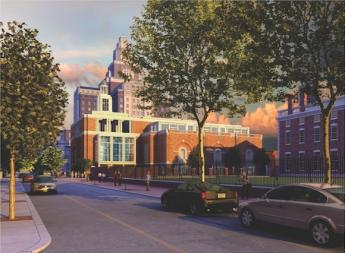
|
| Museum of the American Revolution |
The old visitors center was given a bell by Queen Elizabeth II, who brought it over on the royal yacht and gave a memorable speech at its installation. The deed to the property does not include the bell, and its future is presently uncertain. However, the building will be torn down and replaced by a much larger structure, intended to house many rooms and a tour lasting hours, to show off Washington's military tent and similar artifacts of the low point of the Revolution, when it rested with the personal character of a few founding fathers, to preserve the drive and idealism of the freezing, starving troops. It's a tall challenge for Mike Quinn to carry it off with the right mixture of showmanship and concern for accuracy. After all, no good story is improved by exaggeration.
Main Line: Overbrook to Paoli
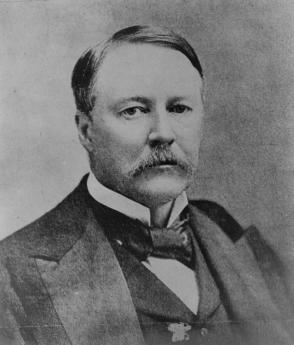
|
| Alexander Cassatt |
Greg Pritchard, who has made scholarship of the Main Line a central part of his life, recently addressed a meeting of the Right Angle Club. To Greg, the Main Line is the set of commuter rail stops from Overbrook to Paoli, representing what was once the heart of the Pennsylvania RR. It changed into a spur of the real main line, running from New York to Chicago, the central monument left by Alexander Cassatt, its president. Times really do change a lot. There is now only one dingy daily passenger train from New York to Harrisburg, which Amtrak would dearly like to eliminate entirely. The Pennsylvania Turnpike was just too much competition, and air travel has eliminated all railroad passenger interest in further points like Pittsburgh, Chicago, and points west. The real main line of long-distance rail on the East Coast now runs north-south, called the Northeast Corridor, essentially beginning in Boston and ending at Washington DC. Philadelphia is central to all of these versions of main lines, although a thirteen-year lawsuit was required to break combined Pennsylvania and New York Central railroads into SEPTA, Amtrak, and Conrail. At the moment, Conrail the freight line is making tons of money, Amtrak the passenger long-haul line would soon die without government subsidy, and all commuter railroads are subsidized by their local communities. There is a lot of talk about billion dollar investments in high-speed trains like they have in Japan and France, but anyone familiar with the economics of rail transportation just shudders at the thought. Railroads are profitable ways to haul long-range bulk cargo. Passenger lines, long and short, can only be justified if they cost less than expanding highway and airline transportation, which the public obviously prefers. Philadelphia is in the peculiar position that the real estate investment has already been made in passenger rail; is it cheaper to build on what already exists, or is that a doomed relic of the past?
But back to Greg's favorite topic, the revered and treasured 19th Century stations on The Main Line. They were mostly built from 1860 to 1890, along the path of what was then the main line to Chicago, but destined to become a spur leading to the real center of east-west traffic, which went from New York to Chicago further north from Philadelphia, intersecting with what became the Philadelphia spur at Paoli. In the days when Philadelphia was one of the richest cities in the world, the spur was a glamorous suburban real estate development. The stations were built, the mansions scattered along at some distance, and servants houses clustered around the stations. The towns were renamed with Welsh names like Bryn Mawr (instead of Humphryville). A culture was built up, probably unique in the world for being centered on railroad executives, and novels like Kitty Foyle and movies like The Philadelphia Story celebrated the glamor of it all. It's probably true that you can find more fifty-room mansions there than just about anywhere else, but the automobile and good public schools mainly drove the prosperity of the 20th Century, as the railroads dwindled away.
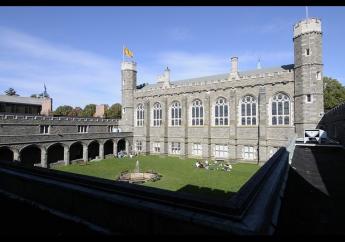
|
| Bryn Mawr College |
The stops on the Main Line begin with Overbrook and continue on through Merion, Narberth, Wynnewood, Ardmore, Haverford, Bryn Mawr, Rosemont, Villanova, Radnor, St. David's, Wayne, Strafford, Devon, Berwin, Daylesford, and Paoli. The main line starts where Philadelphia taxes end and gets progressively newer in harness with the gradual construction of fashionable homes as you get further from the city. At first, Paoli was a place where the out of service trains was stored, but gradually became a fashionable area, which is beginning to leapfrog over the King of Prussia shopping center into the farmlands to the north. The center of gravity of suburban aspirations moves steadily further into the surrounding countryside but is outgrowing the old commuter rail system, and there is something of a movement back to the city. That is to say, urban sprawl is running into the discovery that it's just too traffic-jammed to commute that far, except by train. Most folks are familiar with the jingle that "Old Maids Never Wed And Have Babies" which is supposed to help commuters remember what stop they are approaching. However, the topic mentioned by the jingle and the fact that it ends with Babies (Bryn Mawr) instead of Paoli, strongly implies it was written by a student at Bryn Mawr College for Women.
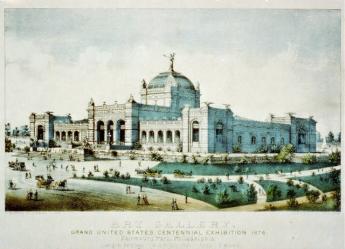
|
| Centennial Exhibition in Fairmount Park |
The old brick stations have been adopted by affectionate commuters, turned into historical preservation societies. They have a varied history, but quite often the station master lived upstairs, and the first floor housed a branch of the post office. When the railroad straightens out its right of way, the stations have to be moved, often at great expense. As they progressed further into the countryside, sometimes grand resort hotels were built for those who wanted to escape the summer heat in the city, or in 1876, to house attendees to the Centennial Exhibition in Fairmount Park. As these hotels lost popularity, they became excellent bargain real estate for a new college, to begin with, a lessened expense, and the upscale neighborhood which soon clustered about the area insisted, that these colleges move up-scale and get good ratings in U.S. News and World Report. Alexander Cassatt insisted that all transcontinental trains must make a stop in Paoli near his home, and there are even a few stations like Upton which were for the sole use of a single estate. So, at one time when ignorant non-Philadelphians on the transcontinental trains would sniff, "Why would the trains all stop out here in the country?", the Philadelphians in the know would just bury themselves in their newspapers.
Footnote: This interesting talk stimulated me to go read some of the history posted in the Main Line station houses, and in particular the one in Narberth. Narberth was a village long before the railroad came along, and it still holds itself a little aloof from the rest. These and similar places relate that Narberth used to be Libertyville, Bryn Mawr used to be Humphrysville, Cynwyd was once Academyville, Marionville became Merion, and Narberth was purchased from William Penn in 1682 by Edward Reese Price. It is also noted that William Thomas donated his property to the PRR in 1851, and the PRR purchased the struggling "Old Columbia" railroad, formerly the "MainLine of Railroads and Canals", from the state in 1857. Narberth quickly became the center of fashionable summer hotels.
Philadelphia's Real Estate Gridlock
IT was spoken hurriedly, and I don't remember who said it. But the gist was that Philadelphia had been the richest city in the world in 1900. In the World, mind you. I can scarcely believe that, but the way it stuck with me shows it had some substance. Rather than comparing Philadelphia with London, New York City, or Paris, I must now compare that exuberance with the dirty, dejected, defeated old wreck of a Philadelphia I first encountered in 1948. Baltimore, Newark and a dozen old American cities sort of crumbled into dust after 1929, but Philadelphia briefly seemed to be picking up in 1948. Richardson Dilworth was getting ready to run for Mayor, and the town's newspapers even enjoyed the idea of a Philadelphia revival. But then the Pennsylvania Railroad collapsed, and after that, we just struggled along, neither dying nor recovering. Some of both, perhaps, but more dying than recovering, and making it credible to believe that Philadelphia just never did recover from the 1929 crash. Just think of that; from top to bottom in thirty years. There just had to be some better explanation than bad management of one railroad.
Until recently, I had accepted the general wisdom that stock market crashes are followed by depressions. Perhaps I am a little slow, but there never seemed to be any question of that analysis, since all major crashes really were followed by recessions, going back to 1792 when Philadelphia had the first American version, and the first financier villain, someone named William Duer. Or maybe it was Robert Morris. Or maybe it was Thomas Mifflin, but in any event, it was someone very rich who did something very reprehensible which toppled the stock market and plunged the rest of us poor victims into protracted suffering. In other scenes of carnage, it had been John Bull, or William Whitney, or Nicholas Biddle. Or J.P. Morgan, that monster. In the 2007 crash, it wasn't so much one villain as one company, Goldman Sachs, or maybe Lehman Brothers. Since the recent crash was so recent, and news coverage so rapid, it might be easier to trace out who the villain was. But there was no one real villain, and even if we found one, it was hard to see why a few days of choked markets would still be causing unemployment seven years later. No one seemed to know, or at least no one wanted to tell me, why stock market crashes cause depressions. They are certainly followed by depressions.
And then suddenly I realized, or maybe someone just broke the news to me, that I had it all backward. Market crashes don't cause depressions, depressions cause market crashes. First, the markets get overheated, everyone gets uneasy, but everyone is making the most money in his life. Suddenly, someone sells out, like shouting "fire" in a crowded theater, and everyone tries to get out the door at the same time. The catastrophe makes everyone see that stocks or real estate, bonds or tulip bulbs, had become ridiculously overpriced, so nobody will buy them at any price. But let's not get down into the weeds of market technicality; prices got disconnected from real values. We overproduced something or even everything, and things wouldn't improve until somebody needed something he had stopped needing, several years earlier. Maybe there were villains, there are always plenty of villains. But we wanted somebody to blame because otherwise, everybody has to take some blame. We needed, in short, a scapegoat.
So let's ask the question again: what caused the great depression of the thirties? And the best answer to come back was the First World War. Philadelphia was the arsenal of democracy, the maker of ships and gunpowder and uniforms. The great transatlantic ocean port, the embarkation point. If we weren't sending troops we were sending tanks and airplanes. The duPonts were sending gunpowder to France, a way of paying back Beaumarchais for sending gunpowder from France to the Battle of Trenton. After their wars were over, one Frenchman went back to making wristwatches and writing plays, and the other munition maker swore off gunpowder and concentrated on nylon stockings. That's far too simple. Philadelphia had expanded and expanded to exploit its wartime advantages. When the war was over the boom was over, but the Roaring Twenties roared. They built mansions, clear out to Paoli and beyond. Movies were written about our hero, who left their jewelry in the vaults of the Girard Bank after the opera while they went back to the horse country at four in the morning. It seems a virtual certainty that no one who acted like that knew what every MBA from Temple now knows: real estate is just about the only link for ordinary people between interest rates and consumption. All assets contribute somewhat to the "Wealth Effect", but real estate is usually the only channel the average person can find, as a way to translate major assets into consumer goods. And since a stock market crash will lower interest rates, the ensuing low cost of mortgages stimulates a real estate boom. Office buildings in the city, mansions in the horse country. But then the city loses its postwar boom and soon loses a million or more population. Result: empty office buildings, empty mansions. Along Spruce and Pine Streets, people moved out of the grand houses and into the servants' houses in the back alleys. Easier to heat.
A friend of mine, whose occupation is locating real estate for businesses, tells me the startling news that land around Philadelphia is too expensive for factories. It seemed hardly credible that real estate could seem so hard to sell, with "For Sale" signs lining the curbs, and yet seem too overpriced for a company to locate here. Suburban Philadelphia house prices were depressed during the Depression so that a seven bedroom Main Line house couldn't find a buyer, but the land was still too expensive for a factory, and anyway, the zoning wouldn't permit a business. Our suburban and exurban land got chopped up into residential real estate, streets were built, sewer lines were extended for miles, trees and ornamentals were planted. Schools and shopping centers were built, maybe some museums and hospitals. But none of that was attractive for a business, and you can't attract an executive to residential real estate without a place to go to work. The features attractive to his wife were not enough to attract him and his business. He wants cheap open land to build factories and vast parking spaces for employees. He doesn't want to get fifty miles away from the port that made Philadelphia prosperous. And he particularly doesn't want to spend his time going to protest meetings about smoke and pollution or go to court to defend his ownership of what someone else polluted, a century earlier. He particularly doesn't want to go to Planned Parenthood meetings with his wife, in order to be hassled about carbon fuels or greenhouse gases in China. Sorry, he's going to build his new plant in North Carolina. And the residential real estate couldn't be made cheap enough for that purpose without tearing down the house, and the schools, and maybe the shopping center. Once the land becomes dedicated, you have to choose: either a nice suburb or a place favorable for a business.
A former President of a Federal Reserve Bank located a thousand miles from Philadelphia was recently here for a conference, and at loose ends for someone to chat with. To my astonishment, he exploded with rage when he contemplated Mr. Obama's refusal to sign permission to build a pipeline from Canada to the Gulf of Mexico. To him, it was obvious that the main thing holding back the American economy was a refusal of American businesses to invest in new plants and equipment. The banks were stuffed with money, but the business refused to borrow it. The Federal Reserve was powerless to stimulate an economy that didn't want to expand, forever pointing to uncertainties of expanding in the face of a regulatory authority which seemed determined to thwart them, to browbeat and humiliate them in front of the TV. It isn't personal, it is serious; because the quarrel is ultimately about important economics. A dollar in 1913 when the Federal Reserve was created, is now worth a penny, and there is every indication of administration eagerness to see the present dollar only worth a penny, far sooner than a century from now. The man speaking was obviously sincere and deeply upset, and what seemed to bother him most was the perception that "the environmentalists" are equally sincere, and thus equally unready to give an inch. The economist regarded the argument of the environmentalists as irrelevant to what was really important, just as surely as the environmentalists were heedless of any legitimacy in the arguments for savaging wildlife. Neither side saw this in terms of the city versus suburbs, or agriculture versus commuters. Neither seemed to acknowledge that a city based on concentric rings had to break the ring pattern in order to maintain a harmonious balance between living well and making a living. That is until the two sides recognize they are talking about the same problem on some level, it will be a dialogue of the deaf, offering no possible resolution except war to the death. It's become a religious conflict, with both sides heedless of things vital to the other side.
They say the main function of real estate brokers is to maintain high prices for property values. But in the long run, if a region isn't prosperous, its residential property will lose value, not gain it.
| Posted by: Tom Lincoln | Jul 30, 2013 6:57 PM |
http://www.torontoweddingchapel.com/
| Posted by: Clarissa | May 14, 2009 1:08 AM |
| Posted by: Dale Weigand | Nov 14, 2008 8:58 AM |
| Posted by: LQ | Oct 24, 2008 5:45 PM |
| Posted by: H Grady Mullis | May 16, 2007 9:13 PM |
40 Blogs
Albert C. Barnes, M.D.
 Impressionist paintings grew more valuable, faster than the patron's endowment for their maintenance.
Impressionist paintings grew more valuable, faster than the patron's endowment for their maintenance.
Bertrand Russell Disturbs the Barnes Foundation Neighbors
 How one of Britain's most notorious philosophers wandered into the city of brotherly love and vaulted out of destitution to wealth.
How one of Britain's most notorious philosophers wandered into the city of brotherly love and vaulted out of destitution to wealth.
Harriton House
 The original house in the old Welsh barony gave its name to Bryn Mawr, and once was the home of the secretary of the Continental Congress.
The original house in the old Welsh barony gave its name to Bryn Mawr, and once was the home of the secretary of the Continental Congress.
Kenneth Gordon, MD, Hero of Valley Forge
 This soft-spoken child psychiatrist was mainly responsible for keeping real estate developers from building houses all over the Valley Forge encampment.
This soft-spoken child psychiatrist was mainly responsible for keeping real estate developers from building houses all over the Valley Forge encampment.
Potts
 Once you get north of the falls of the Schuylkill in Fairmount Park, there aren't many places to ford the river until you get to Norristown, and then Pottstown. That brought commerce to the towns and a lot of military activity during the Revolution.
Once you get north of the falls of the Schuylkill in Fairmount Park, there aren't many places to ford the river until you get to Norristown, and then Pottstown. That brought commerce to the towns and a lot of military activity during the Revolution.
Radioactive River Bend
 The river geography around Pottstown created a lot of history.
The river geography around Pottstown created a lot of history.
Lawn Tennis at the Cricket Club
 Lawn tennis is slightly older than tennis on clay courts, but it's harder to maintain grass than other surfaces, so it's less common.
Lawn tennis is slightly older than tennis on clay courts, but it's harder to maintain grass than other surfaces, so it's less common.
SEPTA's Long Term Planning
 SEPTA is slowly making progress, but it's a struggle, every step of the way.
SEPTA is slowly making progress, but it's a struggle, every step of the way.
Short Tour of Philadelphia's West Country
 Philadelpia County had two hundred farms in 1950, but is now thickly settled in all directions. Western regions along the Schuylkill are still spread out somewhat; with many historic estates.
Philadelpia County had two hundred farms in 1950, but is now thickly settled in all directions. Western regions along the Schuylkill are still spread out somewhat; with many historic estates.
Benjamin Franklin Parkway (2)
 Parthenon-like Art Museum at the other.
Parthenon-like Art Museum at the other.
Contemporary Germantown
 "Well," said Bockus, "Every famous surgeon I know, has a house on an island, somewhere. Where's your island?".
"Well," said Bockus, "Every famous surgeon I know, has a house on an island, somewhere. Where's your island?".
Donor Intent
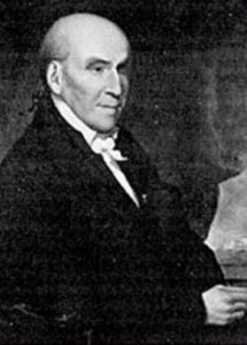 Measure a civilization by how it acts when a donor has died but his possessions endure. Especially when his firmly declared wishes conflict with their own.
Measure a civilization by how it acts when a donor has died but his possessions endure. Especially when his firmly declared wishes conflict with their own.
East Falls
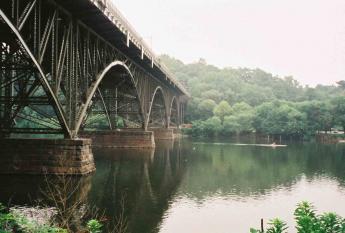 A cute little suburban remnant nestles close to the center of town, protected by the Schuylkill, the Wissahickon, and the shade of John B. Kelly. Perhaps Harry Robinhold deserves some credit, too.
A cute little suburban remnant nestles close to the center of town, protected by the Schuylkill, the Wissahickon, and the shade of John B. Kelly. Perhaps Harry Robinhold deserves some credit, too.
East Park Jingle
 The east side of Fairmount Park is where the grand folks, both Tories and Rebels, had their mansions during the Revolution, and many mansions are still there to be visited.
The east side of Fairmount Park is where the grand folks, both Tories and Rebels, had their mansions during the Revolution, and many mansions are still there to be visited.
Fairmount Park Historic Preservation Trust
 First you must learn how colonial buildings were made, then you have to learn how to do it yourself. And after that, this imaginative preservation society has branched out to help other regions restore colonial buildings.
First you must learn how colonial buildings were made, then you have to learn how to do it yourself. And after that, this imaginative preservation society has branched out to help other regions restore colonial buildings.
Encampment At East Falls
 To follow the story chronologically, however, we must first follow Washington to Moland House in Bucks County, after the first East Falls encampment.
To follow the story chronologically, however, we must first follow Washington to Moland House in Bucks County, after the first East Falls encampment.
Germantown After 1730
 Germantown became the spiritual and intellectual capital of German America as immigrant farmers passed through on the way to better farmland. When Benjamin Chew built his mansion there, it became an affluent suburb as well.
Germantown became the spiritual and intellectual capital of German America as immigrant farmers passed through on the way to better farmland. When Benjamin Chew built his mansion there, it became an affluent suburb as well.
Germantown and the French and Indian War
 In 1750, the frontier was not very far from Germantown, and the pacifist Germans were as conflicted as English Quakers about Scotch-Irish behavior, Indian warfare techniques, and Benjamin Franklin
In 1750, the frontier was not very far from Germantown, and the pacifist Germans were as conflicted as English Quakers about Scotch-Irish behavior, Indian warfare techniques, and Benjamin Franklin
Germantown Before 1730
 The early German settlers of Germantown were religious intellectuals, with a Swiss background and a history of religious martyrdom.
The early German settlers of Germantown were religious intellectuals, with a Swiss background and a history of religious martyrdom.
La Fayette, We Are Here
 LaFayette's first experience in charge of troops very nearly ended in his capture.
LaFayette's first experience in charge of troops very nearly ended in his capture.
Lansdowne
 John Penn, the last of the Penn Proprietors, lived in a mansion near what is now Horticultural Hall in Fairmount Park.
John Penn, the last of the Penn Proprietors, lived in a mansion near what is now Horticultural Hall in Fairmount Park.
Rubberneck Tours of Philadelphia (1)
 A very enjoyable two-hour drive, up to one side of the Schuylkill and down the other, encircles dozens of points of interest. Even if you don't know and don't care that this area was once the training ground for most of the Union Army.
A very enjoyable two-hour drive, up to one side of the Schuylkill and down the other, encircles dozens of points of interest. Even if you don't know and don't care that this area was once the training ground for most of the Union Army.
Sugarloaf
 The Strouds of Stroudsburg used to live here at the top of the town. It's now a conference center.
The Strouds of Stroudsburg used to live here at the top of the town. It's now a conference center.
West Fairmount Park
 Fairmount Park, west of the river, is the largest part. The 1876 Centennial was held there.
Fairmount Park, west of the river, is the largest part. The 1876 Centennial was held there.
Fair Mount
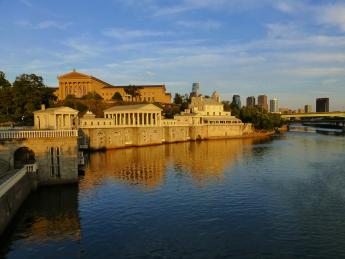 Philadelphia's acropolis is Faire Mount, where the Art Museum marks the entrance to Fairmount Park. Stretching beyond is Boathouse Row and its rowing races. When the azaleas are in bloom, it's the match of any place in the world.
Philadelphia's acropolis is Faire Mount, where the Art Museum marks the entrance to Fairmount Park. Stretching beyond is Boathouse Row and its rowing races. When the azaleas are in bloom, it's the match of any place in the world.
The Schools of School House Lane
 Exclusive privates schools and colleges are usually to be found in isolated rural settings. But our oldest, best, and most famous schools are clustered together in a neighborhood that is far from exclusive.
Exclusive privates schools and colleges are usually to be found in isolated rural settings. But our oldest, best, and most famous schools are clustered together in a neighborhood that is far from exclusive.
The Quaker Who Would Be King
Two Americans, Josiah Harlan, and George Bush conquered Afghanistan, and for centuries others who tried it got massacred. Harlan, a Chester County Quaker farm boy with more brazenness than Alexander the Great, died in San Francisco while impersonating a physician.
The Battle of Germantown: Oct. 3, 1777

Community Volunteers in Medicine
 A little group of medical volunteers in Pennsylvania's Chester County may not understand the underlying issues very well, but they just pitch in and do what they can about the medically underserved.
A little group of medical volunteers in Pennsylvania's Chester County may not understand the underlying issues very well, but they just pitch in and do what they can about the medically underserved.
Fernery
 Around 1840, there was a brief worldwide craze for ferns, related to the exciting discovery of their complicated reproductive process. Only one Victorian fernery still exists in North America, at the Morris Arboretum in Philadelphia.
Around 1840, there was a brief worldwide craze for ferns, related to the exciting discovery of their complicated reproductive process. Only one Victorian fernery still exists in North America, at the Morris Arboretum in Philadelphia.
Morris Arboretum
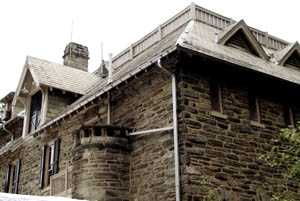 At the furthermost corner of Fairmount Park, the former estate of John and Lydia Morris is run as a public arboretum, one of the two or three finest in North America.
At the furthermost corner of Fairmount Park, the former estate of John and Lydia Morris is run as a public arboretum, one of the two or three finest in North America.
Please Touch
 The Please Touch Museum, a roaring success story, is planning to move too much larger quarters in the Fall of 2008.
The Please Touch Museum, a roaring success story, is planning to move too much larger quarters in the Fall of 2008.
Authors, Writers, Poets, Reporters and Publishers in Laurel Hill Cemetery
Authors, Writers, Poets, Reporters and Publishers in Laurel Hill. Naturally, lots of other people are buried there, too.
Gettysburg
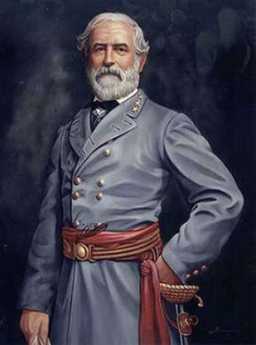 The strategy of both sides in the Battle of Gettysburg was shaped by the type of weapons in use.
The strategy of both sides in the Battle of Gettysburg was shaped by the type of weapons in use.
The Man Behind the Mann
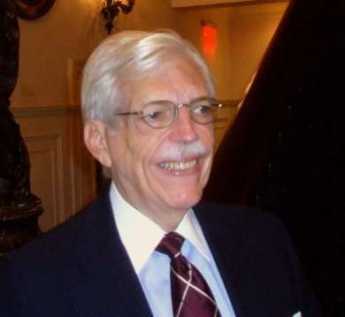
Chester County, Pennsylvania
 When you say Chester County, you are probably talking about horses. There's much more to say.
When you say Chester County, you are probably talking about horses. There's much more to say.
Heavenly House
 In or around Philadelphia, money no object, what's the best place to build a super-mansion?
In or around Philadelphia, money no object, what's the best place to build a super-mansion?
Museum of the American Revolution
 The old Visitors Center at Third and Chestnut has been vacant for more than a decade. Its new occupant is going to be a Museum dedicated to the causes and sacrifices of the American Revolution.
The old Visitors Center at Third and Chestnut has been vacant for more than a decade. Its new occupant is going to be a Museum dedicated to the causes and sacrifices of the American Revolution.
Main Line: Overbrook to Paoli
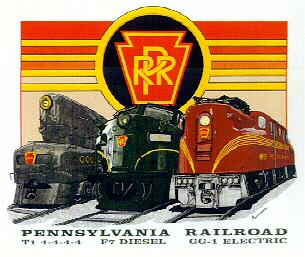 The Main Line was a spur of the Pennsylvania Railroad, connecting Philadelphia to what was the real main line, running north of Philadelphia from New York to Pittsburgh. Times change, the Main Line is a commuter railroad, and there is only one passenger train daily to Pittsburgh. Meanwhile, the real main line is called the Northeast Corridor, Boston to Washington DC.
The Main Line was a spur of the Pennsylvania Railroad, connecting Philadelphia to what was the real main line, running north of Philadelphia from New York to Pittsburgh. Times change, the Main Line is a commuter railroad, and there is only one passenger train daily to Pittsburgh. Meanwhile, the real main line is called the Northeast Corridor, Boston to Washington DC.
Philadelphia's Real Estate Gridlock
Earlier economic disasters may explain what is holding Philadelphia from recovery.